The Story behind the Stone – the families, estates and stories of Kirkmichael, Cullicudden, the Black Isle and beyond
David Urquhart of Braelangwell, the origins of Agneshill and the development of “Tartan Scotland”
text by Dr Jim Mackay; photography as annotated
This is the story of David Urquhart of Braelangwell, and of his parents Charles Urquhart of Braelangwell and Margaret Ross of Inverchasley. It is also the story of how the little settlement of Agneshill in the Black Isle came to be created and named. And I take a wee look at the role of David Urquhart’s brother-in-law, George Hunter, in popularising – with Sir Walter Scott – romantic Scottish culture in the 19th century!
David is commemorated at Kirkmichael by a large black limestone panel in the chancel. There is no memorial to his parents Charles and Margaret at Kirkmichael but it is very likely one would have existed at one time.
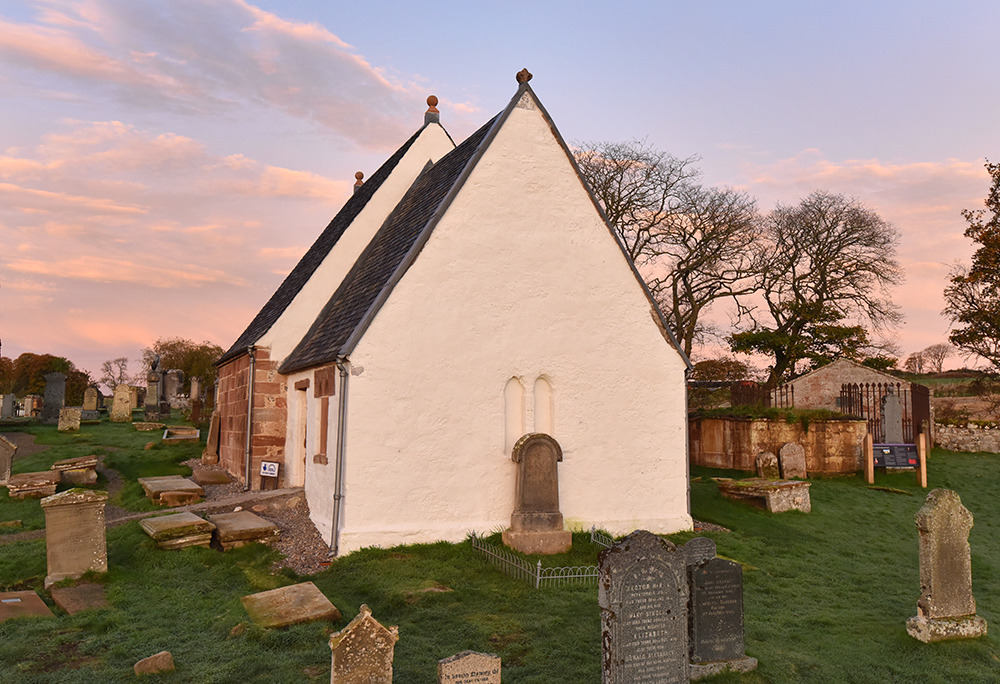
photo by Andrew Dowsett
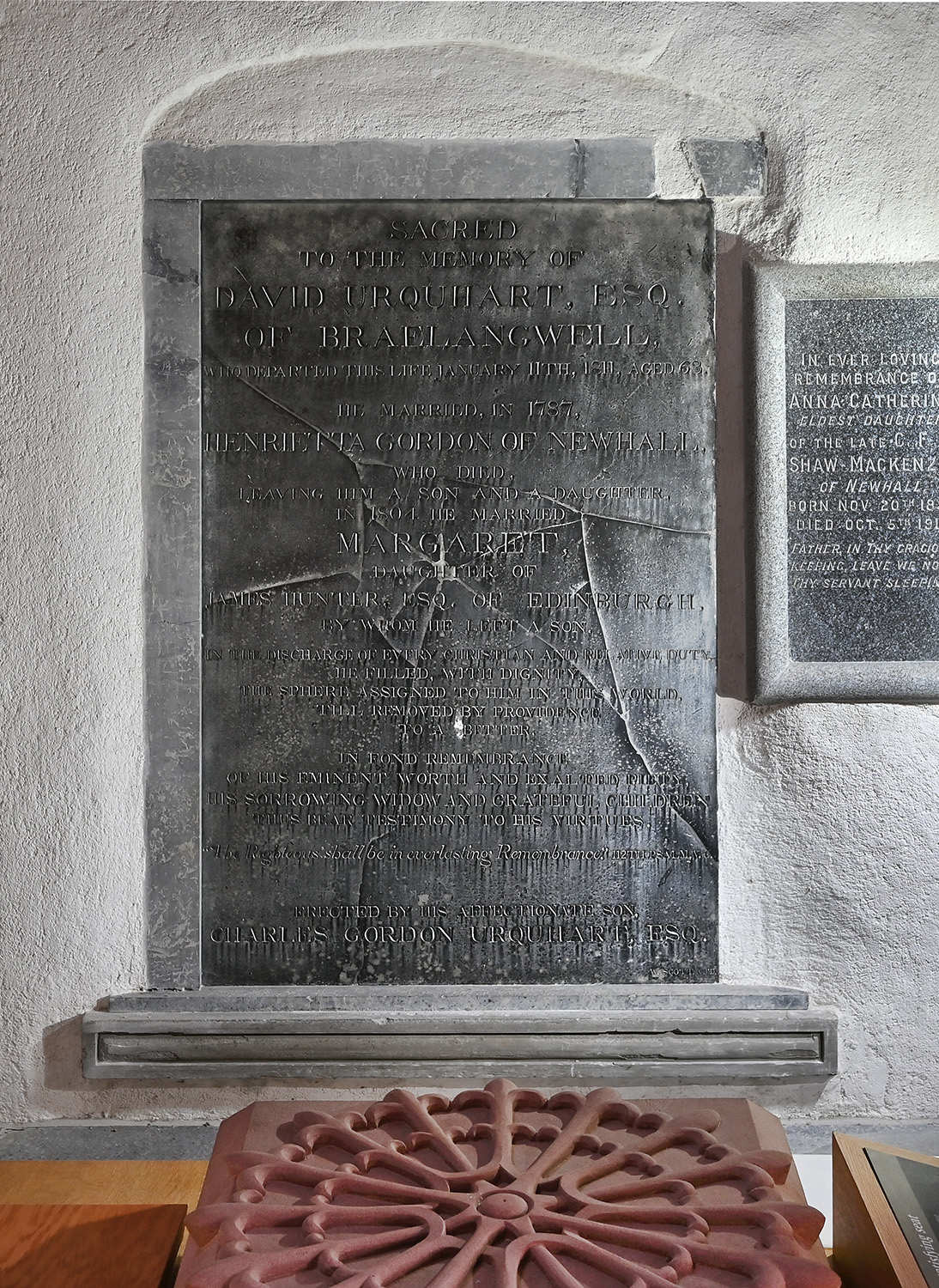
photo by Andrew Dowsett
The lancet windows and the memorial panel
The David Urquhart memorial panel stands in front of the infilled eastern chancel windows. If it were not for the panel and the rubble infill in the lancet windows you would have a marvellous view down the Cromarty Firth to the Sutors. It may have been scenic but it would have been gey exposed on a windy day. In the era before glass windows, shutters would have been slid into place and you can still see the slots for the shutters on the outside of the lancet windows.
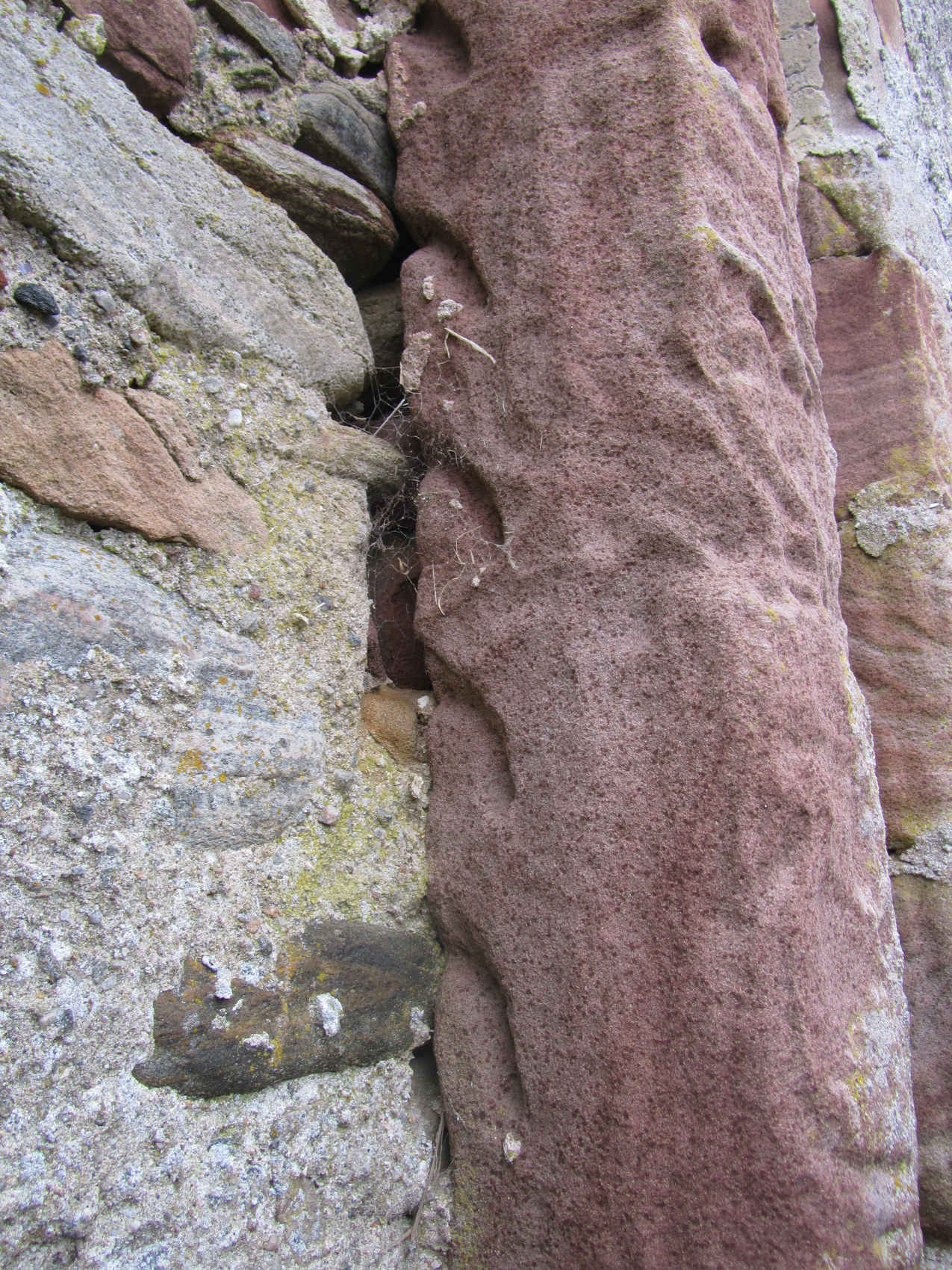
photo by Jim Mackay
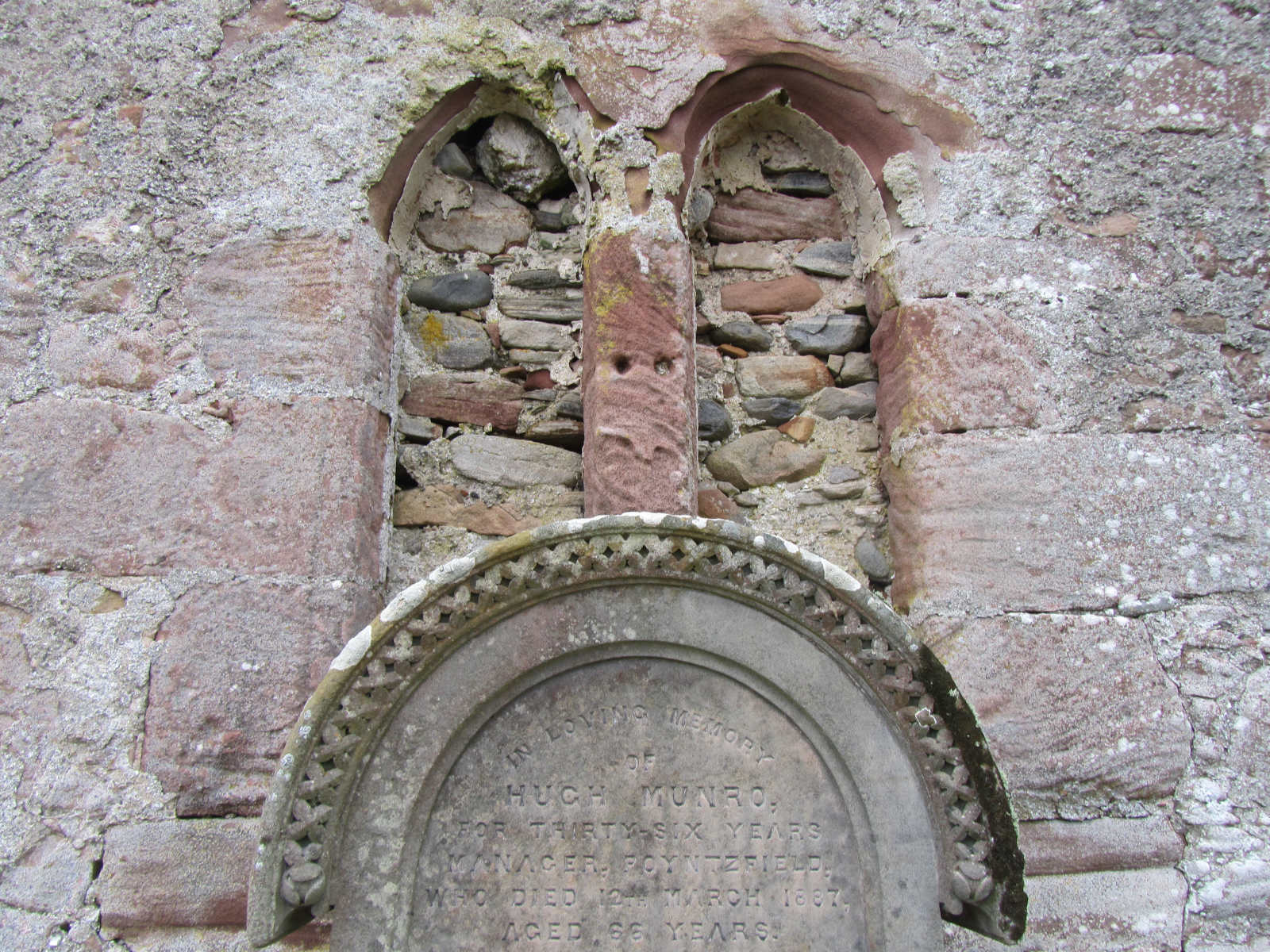
photo by Jim Mackay
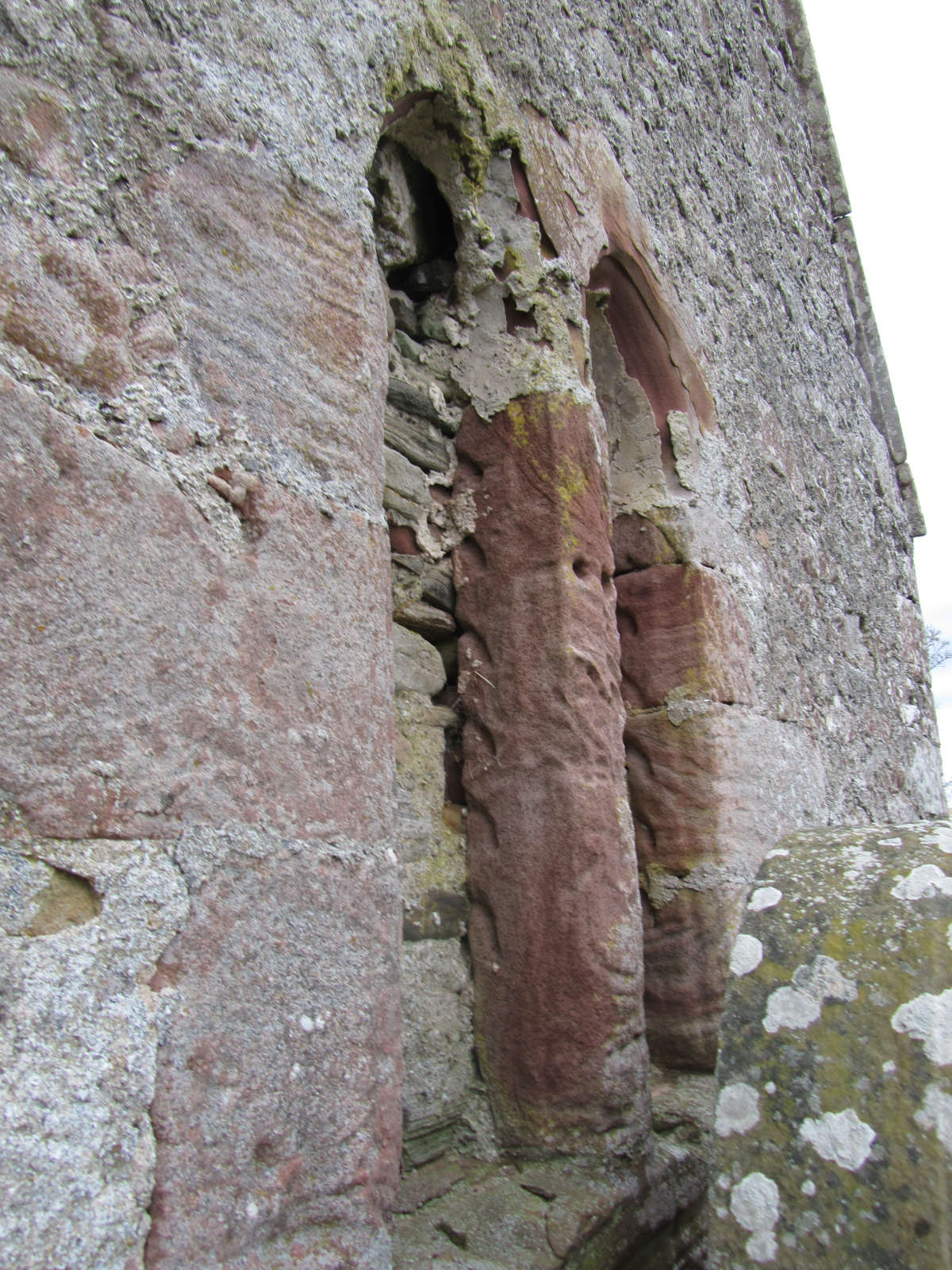
photo by Jim Mackay
The panel had been shattered and as part of the Kirkmichael restoration we had it removed from its setting, cleaned, repaired and replaced with a damp-proof membrane behind it. The story of the restoration of this panel is included in the complementary story on David’s children here.
The sequence photographs below should act as a reminder of the state of the east end of the chancel and the restoration process.
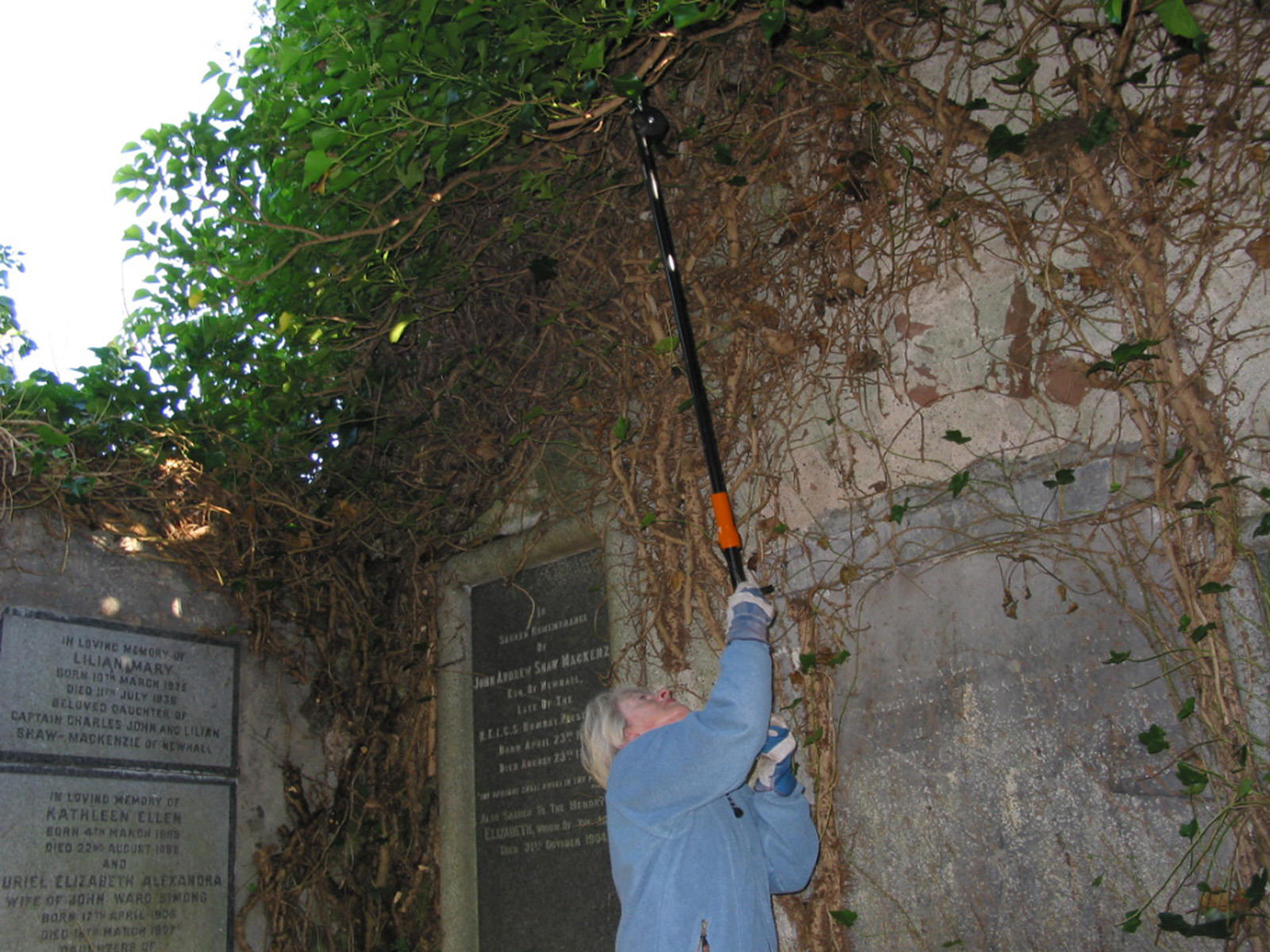
Karina Reynolds cuts back the ivy on the east chanel wall back in, my word, 2002! photo by Andrew Dowsett
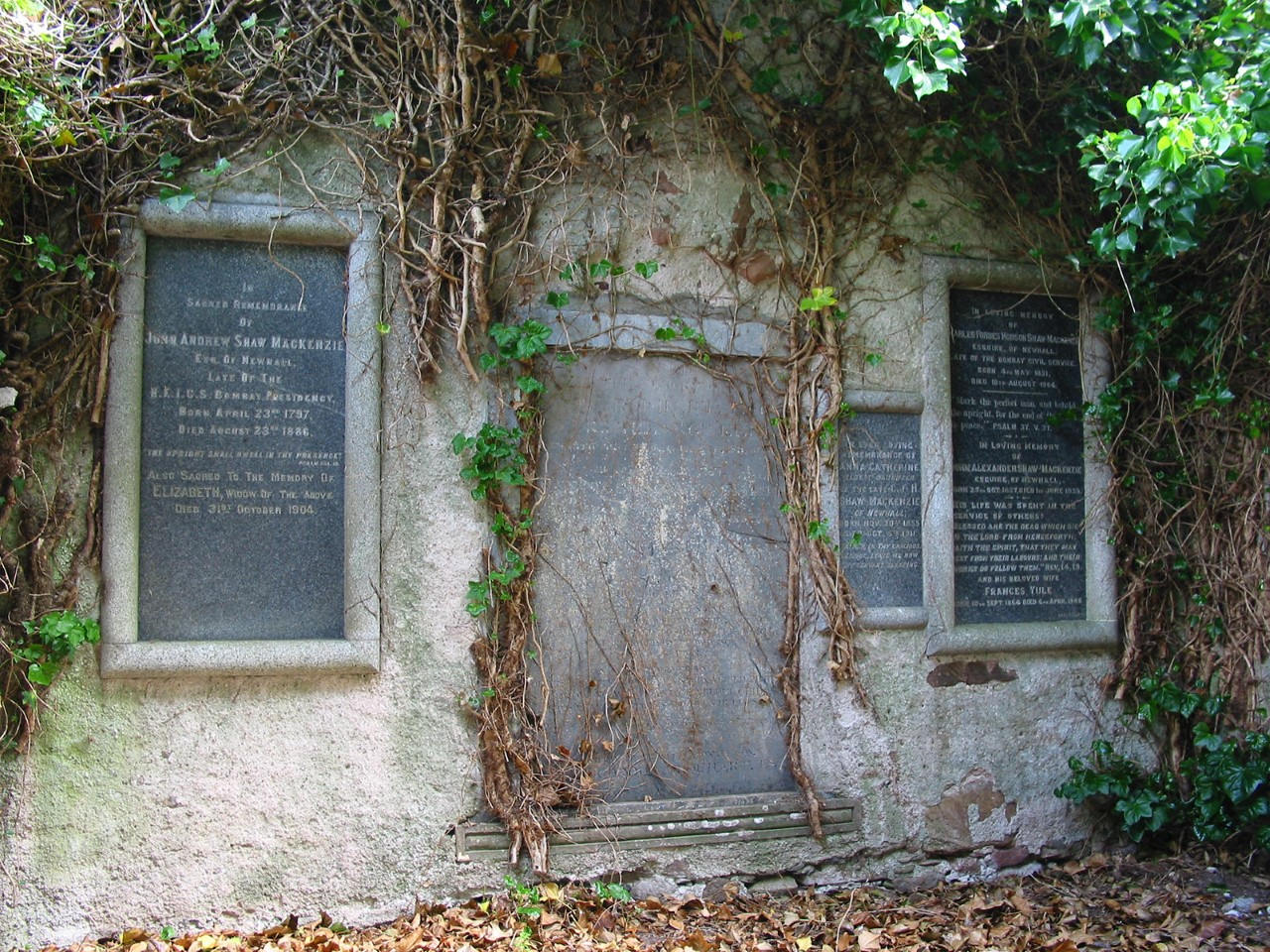
ivy removal was step one in a very long restoraion process; photo by Andrew Dowsett
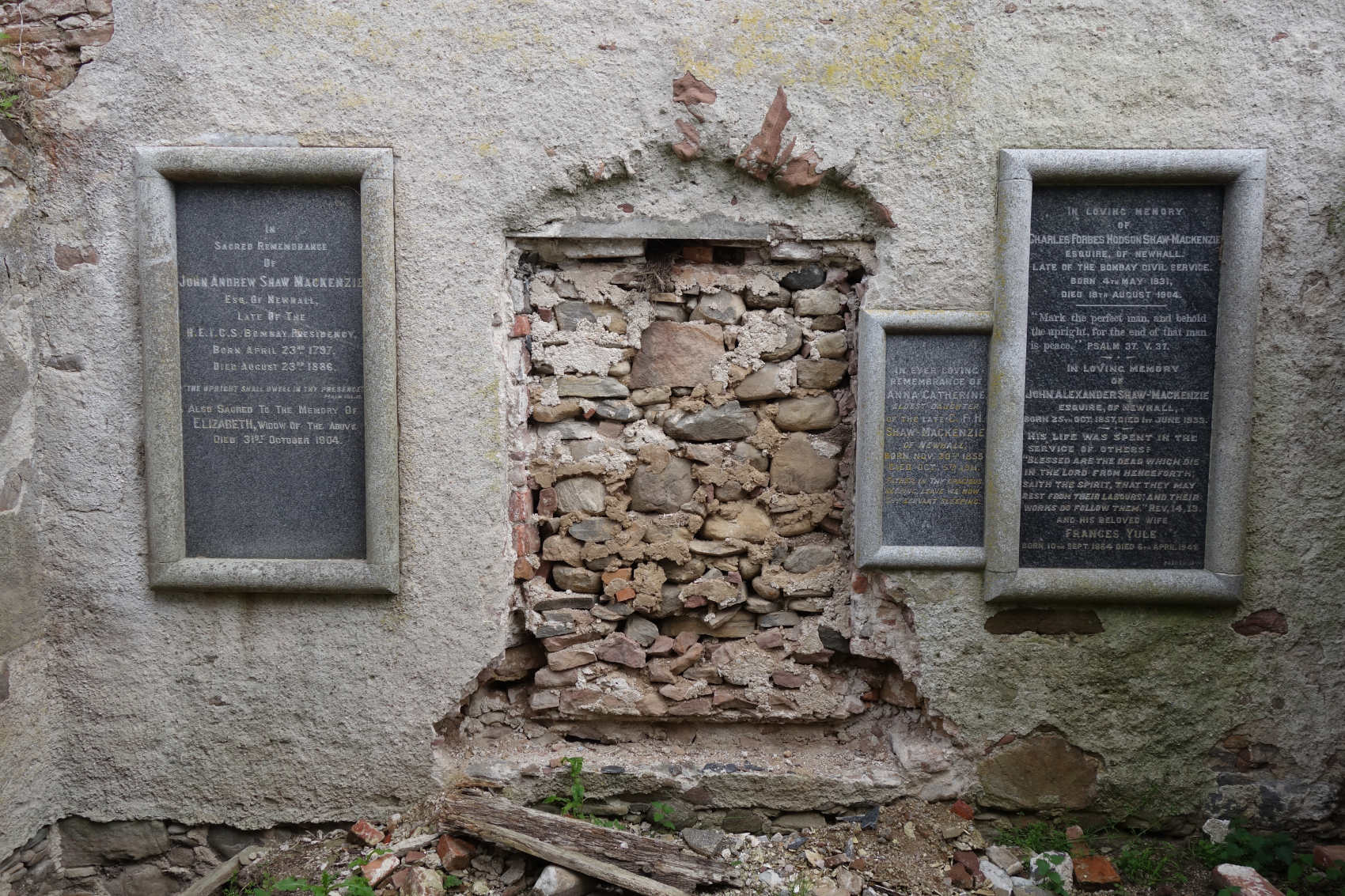
panel removed for repairs; photo by Lynne and Lachlan Mckeggie
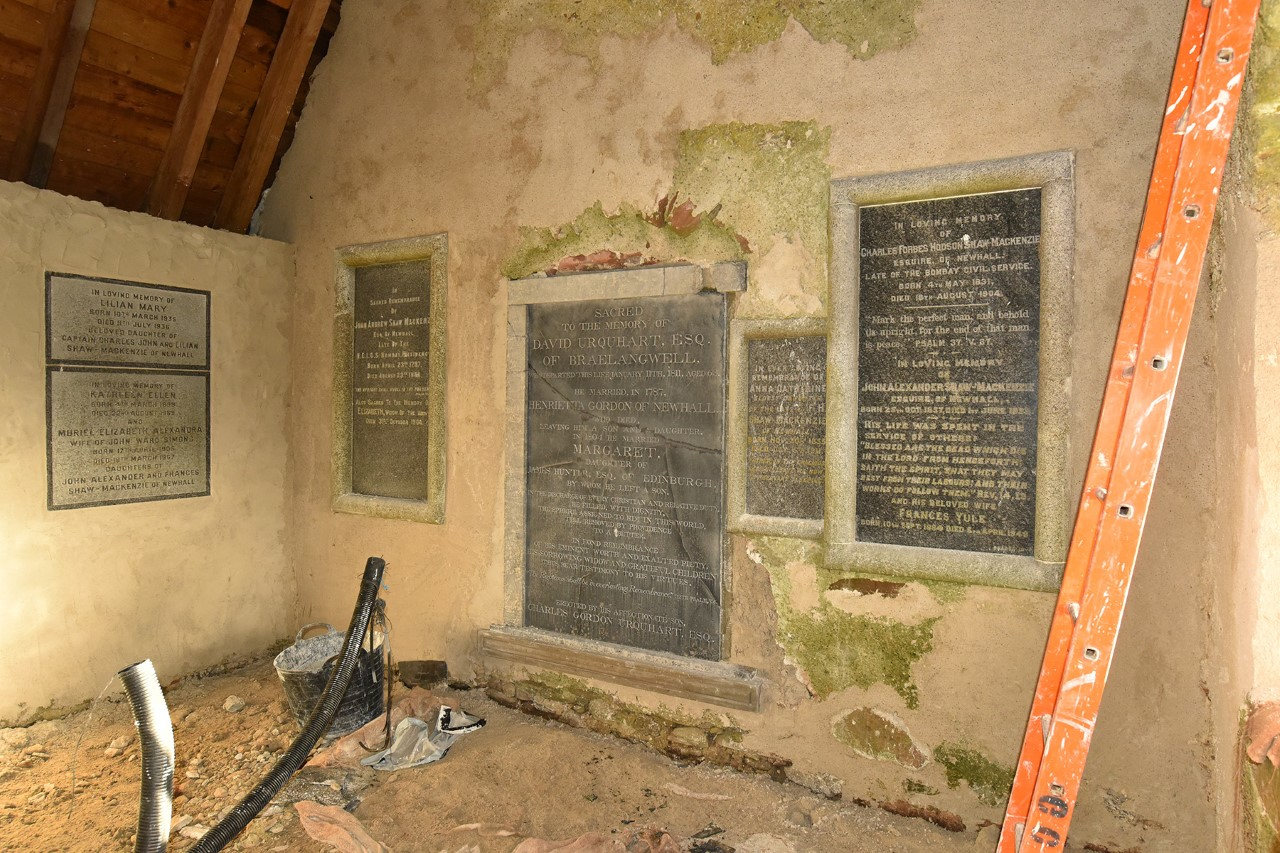
panel restored and re-building works well in progress 10 December 2016; photo by Andrew Dowsett
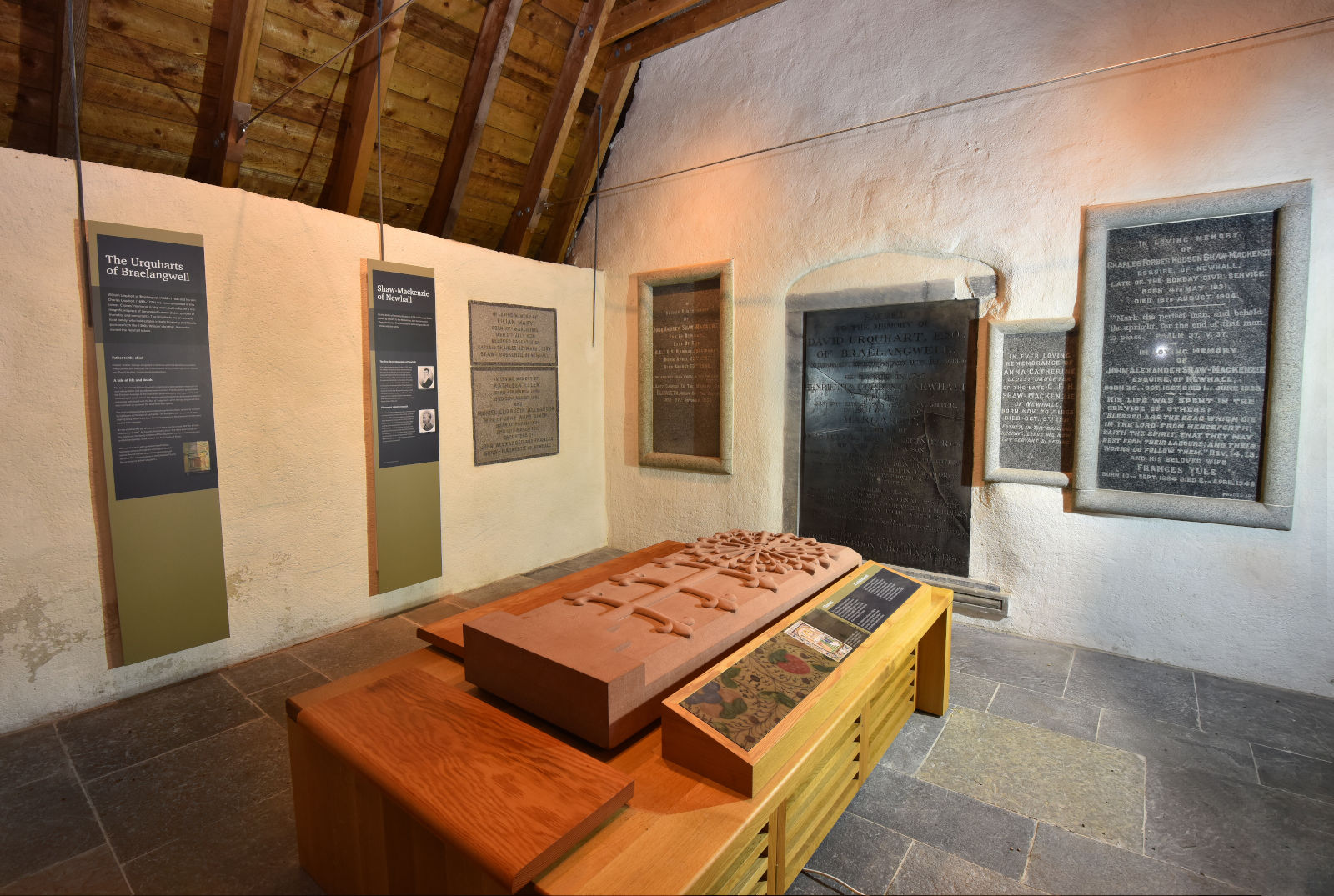
chancel east wall restored; photo by Andrew Dowsett
The missing memorial
Curiously, while there are memorials in the chancel commemorating David’s paternal great-grandparents, Thomas Urquhart of Braelangwell and Henrietta Douglas, and David’s paternal grandparents, Colonel William Urquhart of Braelangwell and Anna McCulloch of Plaids, there is no memorial commemorating his parents, Charles Urquhart of Braelangwell and Margaret Ross of Inverchasley. I have long been puzzled by this. David obviously liked memorials. He was responsible for erecting a large wall panel to his first wife Henrietta Gordon, eulogising her, and a strange sandstone panel commemorating the devotional debt he owed to his grandmother Anna McCulloch, so to omit a memorial to his parents is very strange.
Charles died at Braelangwell, so he would certainly have been buried in Kirkmichael.
I conclude that David did indeed have a memorial erected to commemorate his parents and it has been removed to make space for one of the more modern Newhall stones seen on the north and east walls of the chancel. Bits and pieces of broken memorials turn up at Kirkmichael all the time. During the restoration our archaeologists took photographs of excavation operations, and I noted from one they took of the drain going in that there was something under the tablestone beside the chancel door. From a later investigation on a dark, damp day in December 2017, a sizeable chunk of what was clearly an ornate wall panel emerged. A “V” usually represented an Urquhart. Who knows but this may have been part of the missing memorial to Charles Urquhart and Margaret Ross!
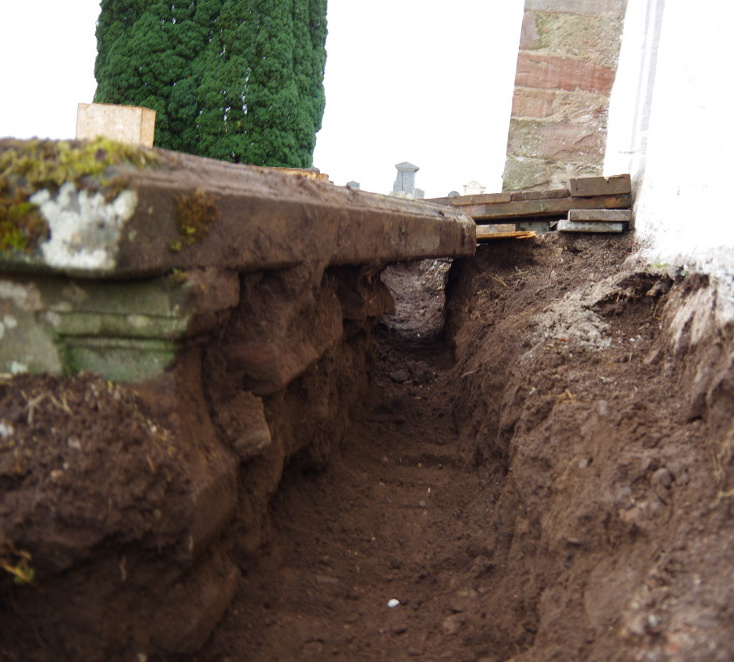
something mysterious under that tablestone; photo by Lynne and Lachlan Mckeggie
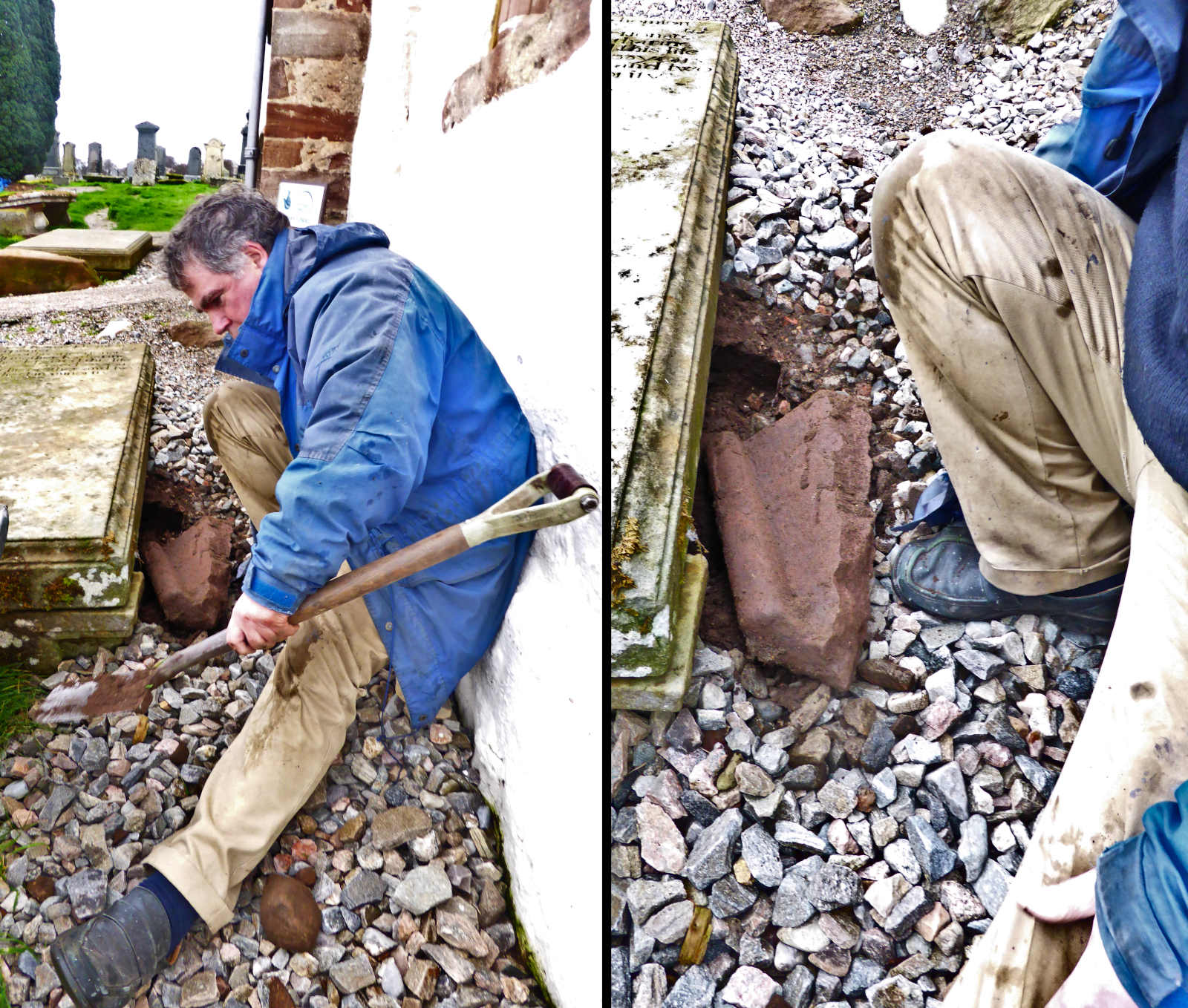
what was that mysterious object? photos by Davine Sutherland
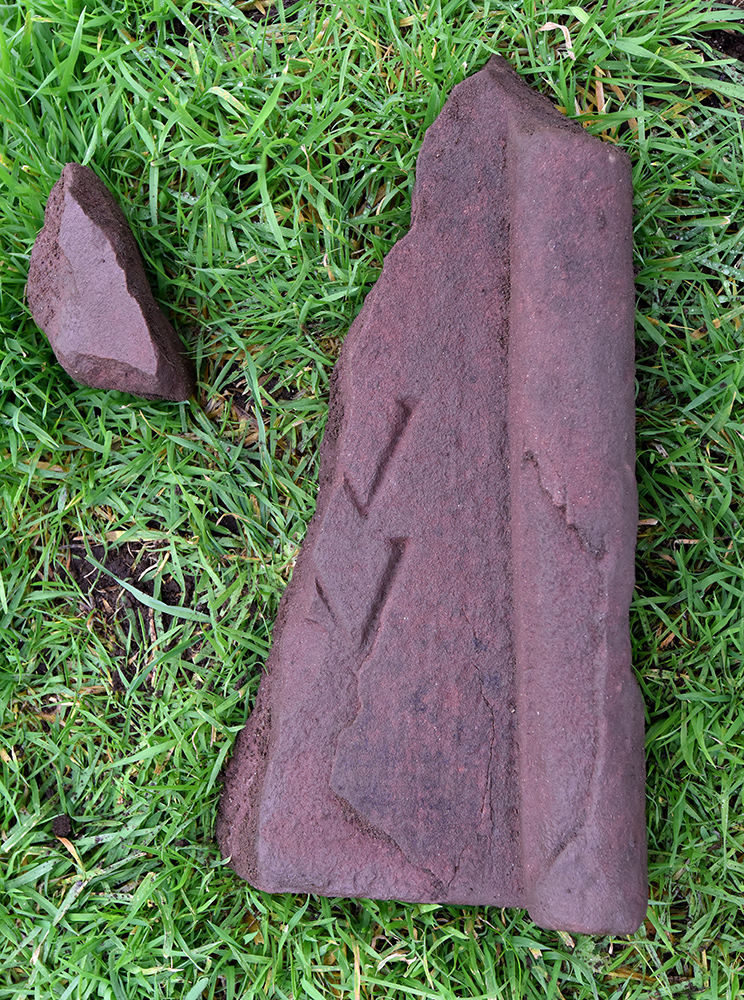
definitely part of a wall memorial panel; photo by Andrew Dowsett
Charles Urquhart of Braelangwell – early days
There seems to be much confusion on the web regarding the children and marriage of Charles Urquhart’s parents, William Urquhart of Braelangwell and Anna MacCulloch of Plaids. Just to nail the marriage, here are extracts of the sasine registered in February 1693 following the matrimonial contract signed at Tain on 17 October the previous year, i.e. 1692. I don’t usually go into this much detail but sometimes you just have to return to the original documentation to prove a point! One detailed family tree of the Urquharts of Braelangwell on line at time of writing is almost entirely fantasy. So:
Register of Sasines RS38/5 folio 601 verso 1693
At Fortros the tuentie fifth day of Februar Jaivi& Nyntie three yrs … produced be John Dallas wrytter in Fortrose and reg[ist]rat in maner following … in presence of me not. pubt. and witnesses undersubscribing compeared personally Charles MacCulloch Chirurgeon Burges of Taine as pro[curato]r and actorney for and in name & behalf of Anna MacCulloch his only daughter … of the lands and others aftermentioned to ye effect after specifit, having and holding in his hand ane Contract matrimoniall … William Vrqrt of Brealanguall on the ane pairt and the sd Charles McCulloch for himself and as takend the full burden in and upon him of the sd Anna MacCulloch his sd daughter, And the sd Anna MacCulloch for herself, with consent of her sd father on ye other prt; Be virtue qroff (and for the reasons and causes mentioned in the sd Contract) the sd William Urqrt her. proprietor of the lands and others underwritten with the pertinents gave grantit and disponed to ye sd Anna MacCulloch now his spouse in lyffrent during all ye dayes of her lyfetyme, And the Airs male to be procreat in ye sd marriage … all and hail that wester quarter of ye toun & davoch land of Brealanguell called Woodhead, together therwith these Crofts and particats of land … following viz: That croft of land called Culballachie, with the little croft next adjacent therto and be-west the same, And both ye sd crofts lyand at ye north or north-west of the sd land of Brealanguell. And in lyke maner all and hail that six bolls of bear yearly pay of land being a particat of ye sds lands of Brealanguell, And nixt adjacent to ye sd Croft of Culbalachie, extending in the hail as three Chalders victual of yearly pay. And siclyke the maner place of the said toun and lands of Brealanguall, with the hail office houses pertaining to ye samen, together with all other houses biggings … all lyand within ye parochin of Kirkmichaell and Shirriffdome of Cromartie … during ye sd Anna MacCullochs lyffetime; As ye sd contract matrimoniall of ye dait att Tayne the Seventint day off October last bygone …
The witnesses to the performance of the sasine are of interest: “In presence of Mr David Houstoun lawfull sone to Mr James Houstoun minir. of Kirkmichaell and Cullicuddin and Donald Taylor in Brealanguell, maister John Urqrt brother german to Brealanguell, and John Ferne wrytter in Tayne”. David Houston in St Martins was married to one Mary Urquhart (Register of Sasines RS38/8 folio 521), so a family connection is clear. John Urquhart, brother to Braelangwell, i.e. brother to William Urquhart, was a minister (“Maister”). It is excellent to see his presence in the Black Isle at this time as he would become the Reverend John Urquhart of Gartly (and later St Andrew’s in Elgin) and in fact is from whom the present Urquhart Clan Chief is descended.
Various sources give the birth year of Charles Urquhart of Braelangwell as 1699, and although I have not seen the evidence of this myself it must be about right. He would have been named after his maternal grandfather, Charles MacCulloch. His father, William Urquhart (1660–1708), died at Braelangwell at a relatively young age, when Charles was only about nine years old. Charles was therefore brought up by his devout mother, Anna MacCulloch of Plaids (1670?–1752).
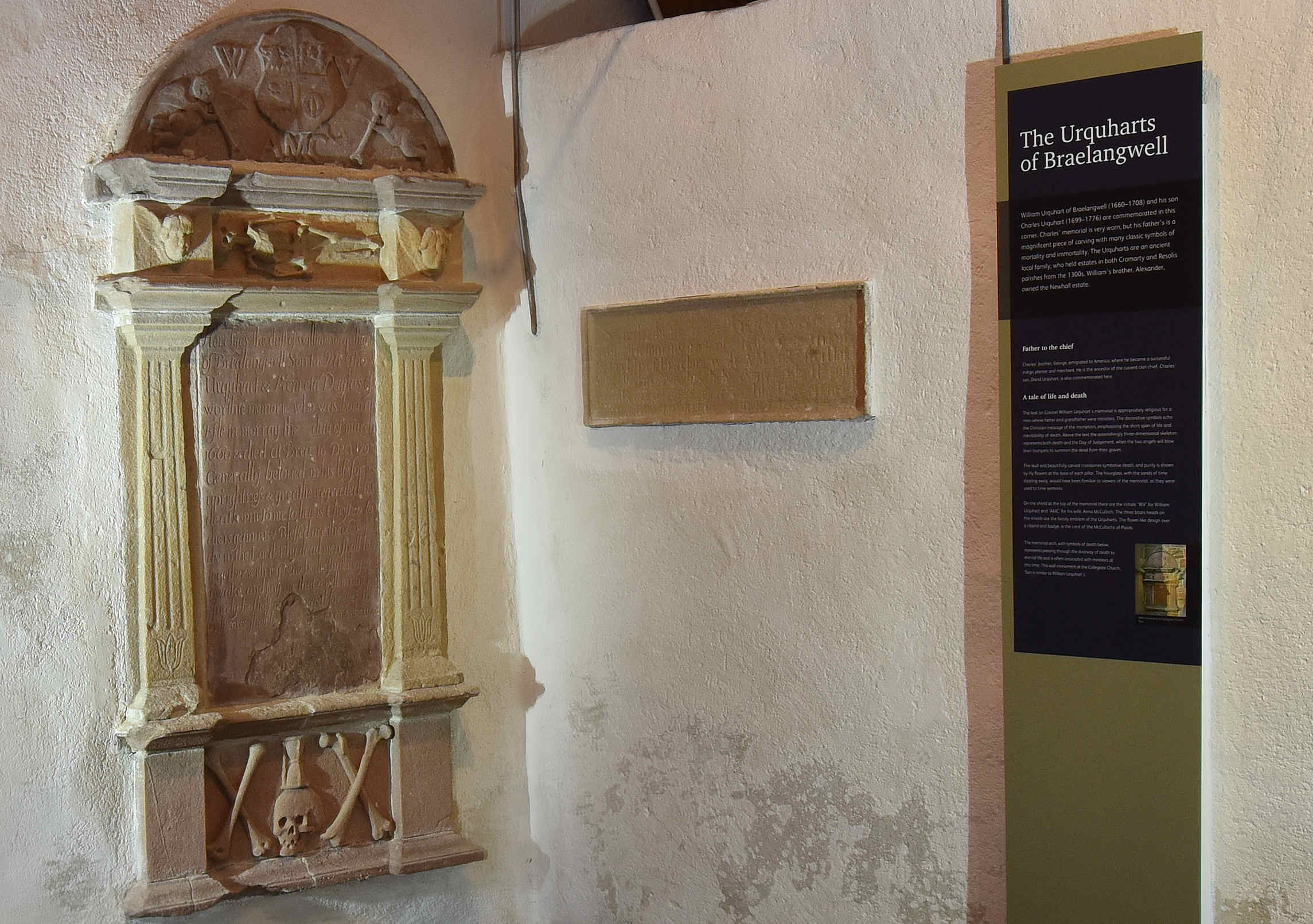
Memorial to William Urquhart and his parents (left) and to Anna MacCulloch (right). The only reference to Anna on the left memorial is in her initials and the MacCulloch ermine heraldry at the top, and David Urquhart must have felt that his grandmother deserved more than this.photo by Andrew Dowsett
We have a developing Story behind the Stone devoted to Anna MacCulloch here.
Marriage to Margaret Ross of Inverchasley
Charles married Margaret Ross of Inverchasley in 1727, as confirmed in the sasine registered the following year. This is my transcript of the sasine – there is much of local interest in it but I have summarised it drastically. You will see that as Anna MacCulloch, the mother of Charles, was still alive and had Braelangwell House as her home under her matrimonial contract, Charles had to make alternative arrangements for Margaret.
Register of Sasines RS38/8 folio 379 verso – 380 verso
Att Fortrose the [28 Sep 1728] … pertaining to Margaret Ross afterdesigned was presented by Patrick Hay Burges of Fortrose … compeared personally upon ye ground of ye lands & oyrs undernom. John Barnett tenent in Braelangwell Baillie in yt part … and also compeared Donald Ross servitor to David Ross Commissary Clerk of Ross actorney for and in name & behalf of Margaret Ross second lawfull daughter to ye deceast David Ross of Inverchasley now spouse to Charles Urquhart of Braelangwell (whose power of Actorney to ye effect underwritten was sufficiently known to me) having & holding in his hands a Contract of Marriage of ye date under containing yrin ye precept of Sasine afterinfeft made & past twixt ye sd Charles Urquhart on ye one part and ye sd Margaret Ross with the advice & consent of David Ross now of Inverchasley her oldest brother german on ye oyr part whereby in Contemplation of ye marriage then contracted & yrafter solemnized twixt ye sd Charles Urquhart & Margaret Ross the sd Charles Urquhart gave granted & disponed to and in favours of ye sd Margaret Ross in Liferent during all ye dayes of her Lifetime after his own decease all & haill … Five Chalders farm victual yearly to be possessed uplifted & taken lyke furth of all & haill ye Lands & Mayns of Braelangwell & yearly yt part of ye sds lands & maynes lying betwixt ye Two Burns Called Aldcharmich & Duack which extends to ye yearly pay of Four Chalders farm victuall togdr with as much of ye sd lands of Braelangwell next adjacent to & lying immediately to west ye sds Maynis as does extend to sd chalders victual &hellipthe sd Charles Urquhart yrby bound & oblidged him his heirs & successors to infeft and sease ye sd Margaret Ross in Liferent to be holden and with warrandice in manner yrin exprest. But because Anna McCulloch ye sd Charles Urquharts mother has ye Liferent Right of ye sds haill lands of Braelangwell princll dwelling house yeard & office houses thereof excepting ye sd Four Chalders pay of ye lands lying twixt ye sds two burnes in case it should happen ye sd Charles Urquhart to decease before his sd mother & spouse the sd Charles Urquhart then Band & oblidged him his heirs & successors to Content & pay to ye sd Margaret Ross her heirs & oyrs yrin expest ye sum of Fourty pounds Scots Money at Whitsunday & Martinmas yearly for farming a house to her for all ye years as she shall be precluded after his decease from ye possession of ye house of Braelangwell during his moyrs lifetime As also to Content pay & deliver to his sd spouse & her forsds ye quantitiy of One Chalder good & sufficient victuall … yearly for all Cropts & years of his sd mothers lifetime afer his own decease in manner more fully mentd in ye sd Contract of Marriage as ye same of date the Eight day of June Jaivii& & twenty sevin years containing yrin Clauses of Warrandice assign … written on Stampt paper by Robert Dallas servitor to Hugh Dallas Town Clerk of Fortrose … before these witnesses George Monro of Newmore George Monro of Culrayne & ye sds Hugh & Robert Dallas sic subscribitur Cha: Urquhart Margaret Ross David Ross Geo Monro witnes George Monro witness Hugh Dallas witnes Robert Dallas witnes … [sasine winds up] in pns of William Monro lawful son to Hugh Munro in Drommond Alexander Barclay in Bellacherry and John Fraser my servitor …
Charles did not like Margaret’s elder brother, mentioned in this sasine, the second David Ross of Inverchasley (father of the famous Lord Ankerville). He felt he liked money too much to be trustworthy. However, the marriage contract approved by David Ross here was designed not for his benefit but to protect the interests of his sister.
From a small snippet in a later letter from Charles, I do not believe that Margaret’s health was robust. Despite this, she seems to have had a fair number of children over the years. The surviving Resolis baptism register just starts at the end of this period so we cannot tell exactly how many children they had. From a later legal document, I understand only one son (David) seems to have survived to adulthood, but I know of several daughters. With very approximate dates, these are the children for whom I have seen solid evidence.
Children of Charles Urquhart of Braelangwell and Margaret Ross of Inverchasley (married in 1727)
1. One daughter of Charles and Margaret must have married a gentleman named Munro, as David Urquhart in his will written in 1811 provides an annuity “To Margaret Munro my Niece”.
2. Christian Urquhart (c1734–1796), married in 1777 Hugh Inglis, Baillie of Inverness, as his third and last wife. The marriage did not result in any children. She died in Edinburgh and is buried in St John and St Cuthbert joint Church Cemetery, although Hugh’s first and second wives are commemorated on separate memorials in Chapel Yard, Inverness. The Inglis family had been associated with both the Parish of Resolis and the Urquharts of Braelangwell. The Reverend Thomas Inglis (1684–1747) had served as minister in the united parish of Kirkmichael and Cullicudden commonly called Resolis until his death. He had married Anne (–1742), the sister of Charles Urquhart of Braelangwell, and Charles became one of the curators put in place in 1748 to John and Jean Inglis, still minors on the death of the already-widowed Reverend Thomas Inglis in 1747. I am grateful to Eona Bell, who is researching her Inglis family, for drawing to my attention the link to Christian’s Braelangwell parentage (a letter from George, the son of Hugh Inglis, as referred to within document D90/23 in the Highland Archive Centre). It had seemed almost certain and that letter clinched it.
PHOTOS OF MEMORIALS TO FIRST AND SECOND WIVES TO BE INSERTED HERE
Christian was obviously resident in Edinburgh at the time of her death and was interred in what seems to have been a family burial area (see the burial register entry below). No other Urquhart names are present in her close proximity. However, the memorial to the family of accountant William Macao, who was a close associate of the Urquhart family, is a panel that matches her panel in style and is immediately adjacent to it.
St John and St Cuthbert joint Church Cemetery Inscription
To the Memory of Mrs Christian Urquhart Relict of the Deceased Hugh Inglis Esqr. Died 17th February 1796, Aged 62 Years.
Edinburgh is one of those select areas where there are parochial burial records, although Christian’s one contains a mistake, naming her husband instead of Hugh Inglis as William Inglis (the son of Hugh and future provost.of Inverness) but it confirms the Kings Mills connection and that the family had a lair in St John and St Cuthbert.
Edinburgh Burial Register
1796 Febry … Urquhart 19 Christian Urquhart Relick of the Deceast Willm. Inglis of Kings Mills near Inverness from Ross Street New Edin. a Hearse Turf &c Train Lyes in the Middle of the family property or Tomb 62 [cause] Decline
I think the “Ross Street” will be Rose Street in New Town of Edinburgh, running parallel to George Street where David Urquhart of Braelangwell was living at the time. Rose Street was where family acquaintance accountant William Macao resided. Indeed, I wonder if she may have been living in the Macao family home.
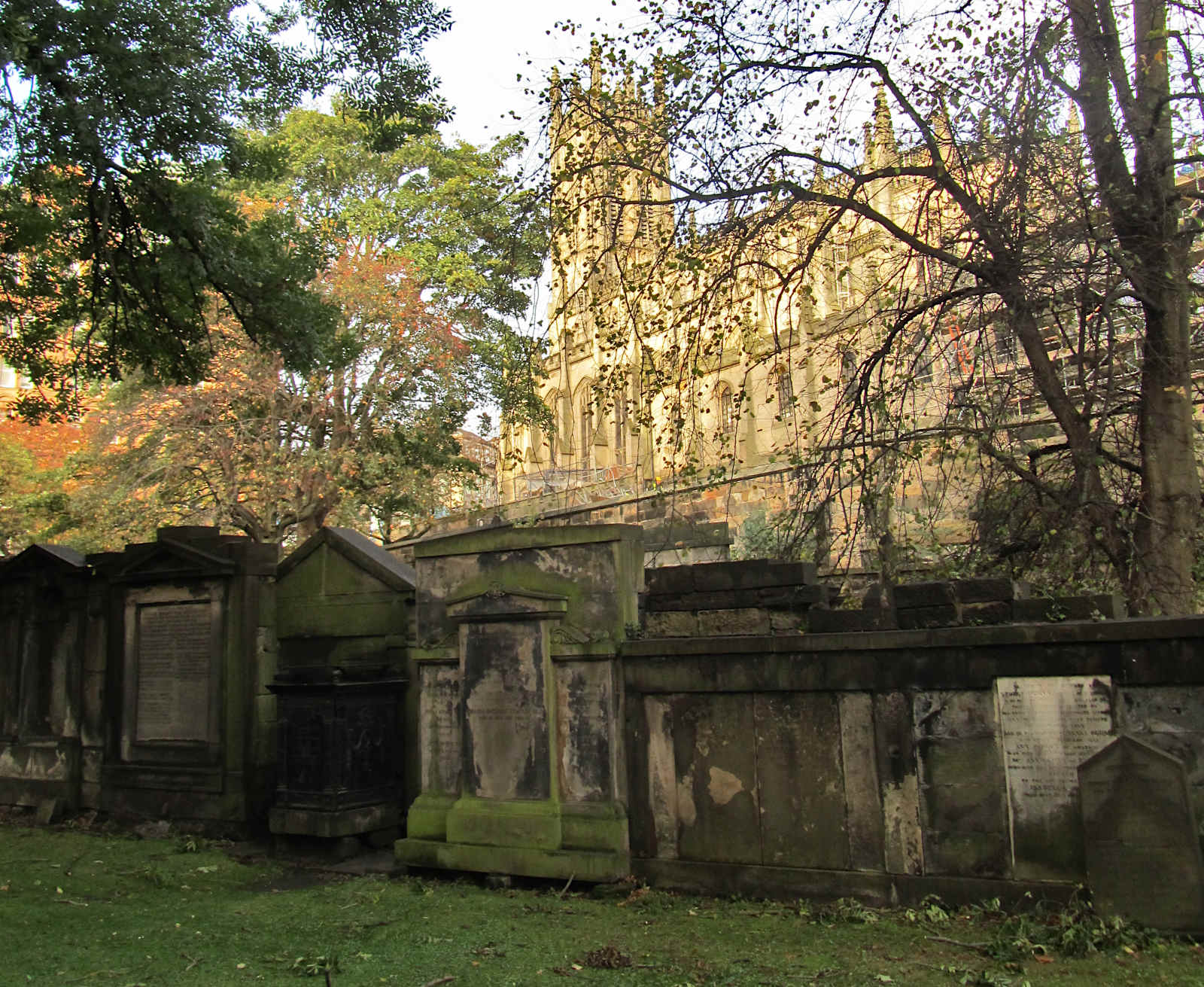
the two panels are together in the centre; photo by Jim Mackay
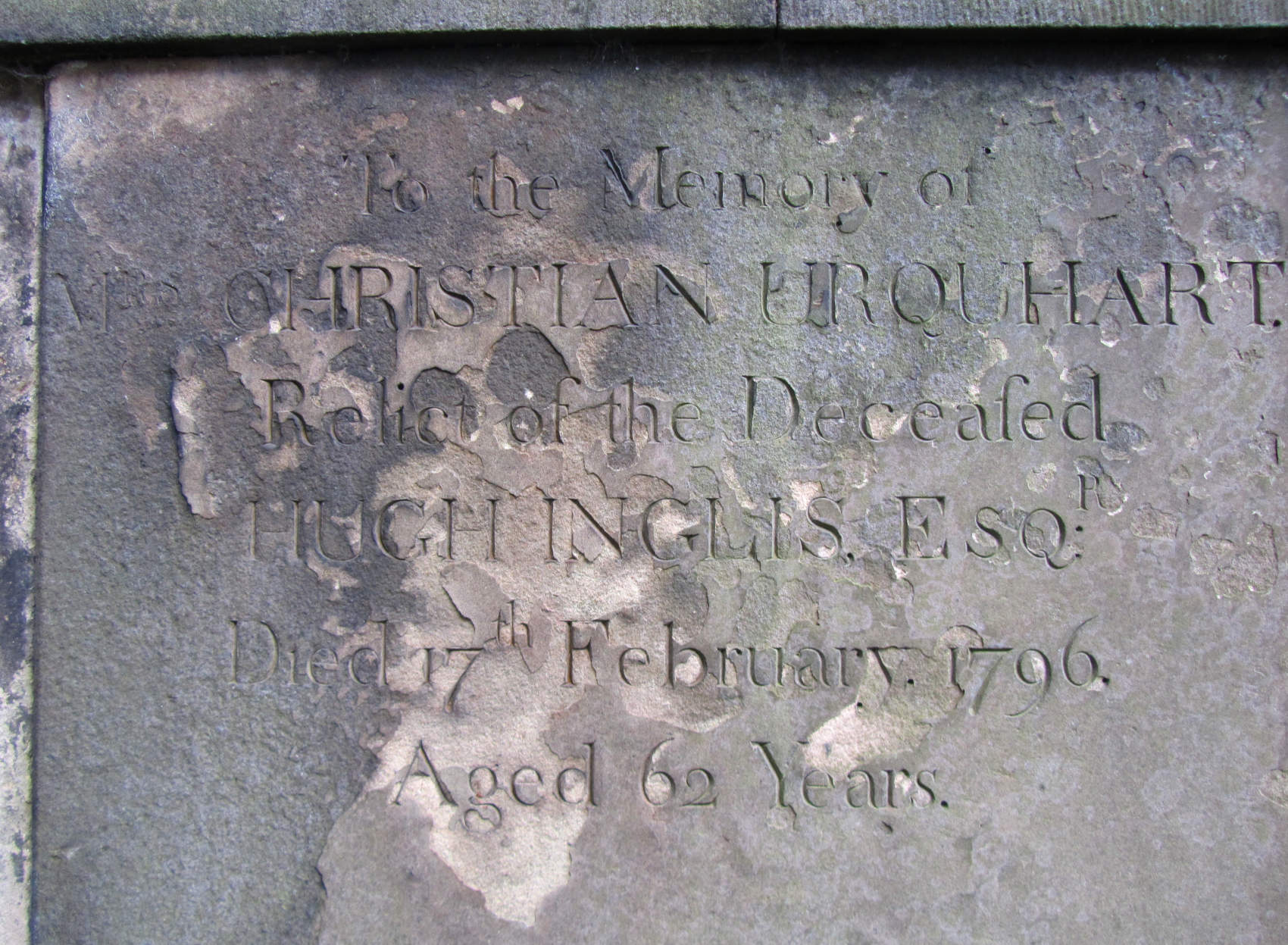
the Christian Urquhart panel; photo by Jim Mackay
As the adjacent Macao was a family acquaintance, I thought I would check the burial register for relevant entries, and combine that information with the inscription:
Edinburgh Burial Register
1802 … October …25 A Stilborn Child of Mr Macco of the Excise from Rose Street Lyes in the NE corner of the family Tomb Close to the N Wall [cause] Weakness
1802 … October … 31 Mrs Helen Ross spouse of Mr. Macoa from Rose Street Lyes 2 ft S from the N Wall of the family Tomb [age] 29 [cause] Childbed
St John and St Cuthbert joint Church Cemetery Inscription
Here are deposited in the humble hopes of eternal Life the Remains of HELEN ROSS Spouse of WM: MACAO, Accountant of EXCISE, and eldest Daughter of WM: Ross Esqr: late of INVERCHARRON who died 28th: October 1802. Also her Infant SON who died 21st: Instant.
WILLIAM MACAO died 31st Oct. 1831, Aged 78 Years.
Helen Ross, as the inscription says, was a daughter of Ross of Invercharron. Charles Urquhart of Braelangwell had married Margaret Ross of Inverchasley. The Ross families of Invercharron and Inverchasley were related but I have no intention of attempting to set out the complexities of Ross connections in Easter Ross! But we can assume that Christian Urquhart and William Macao’s wife, Helen Ross of Invercharron, were relatives.
I have seen some references, by the way, to “Ross of Braelangwell” in this context – but the Braelangwell referred to here is the fishing and shooting estate up by Ardgay!
The Inglis connection with the Urquharts was to continue. I note that Henrietta Urquhart ms Gordon was to sell in 1795 a four acre strip of land at Gordon’s Mill to William Inglis Merchant in Inverness – the son by an earlier marriage of Hugh Inglis, he who had married Christian Urquhart in 1777. The intention was for William to erect a woollen mill on this land, presumably to complement the mills previously erected by the Gordons on the adjacent land.
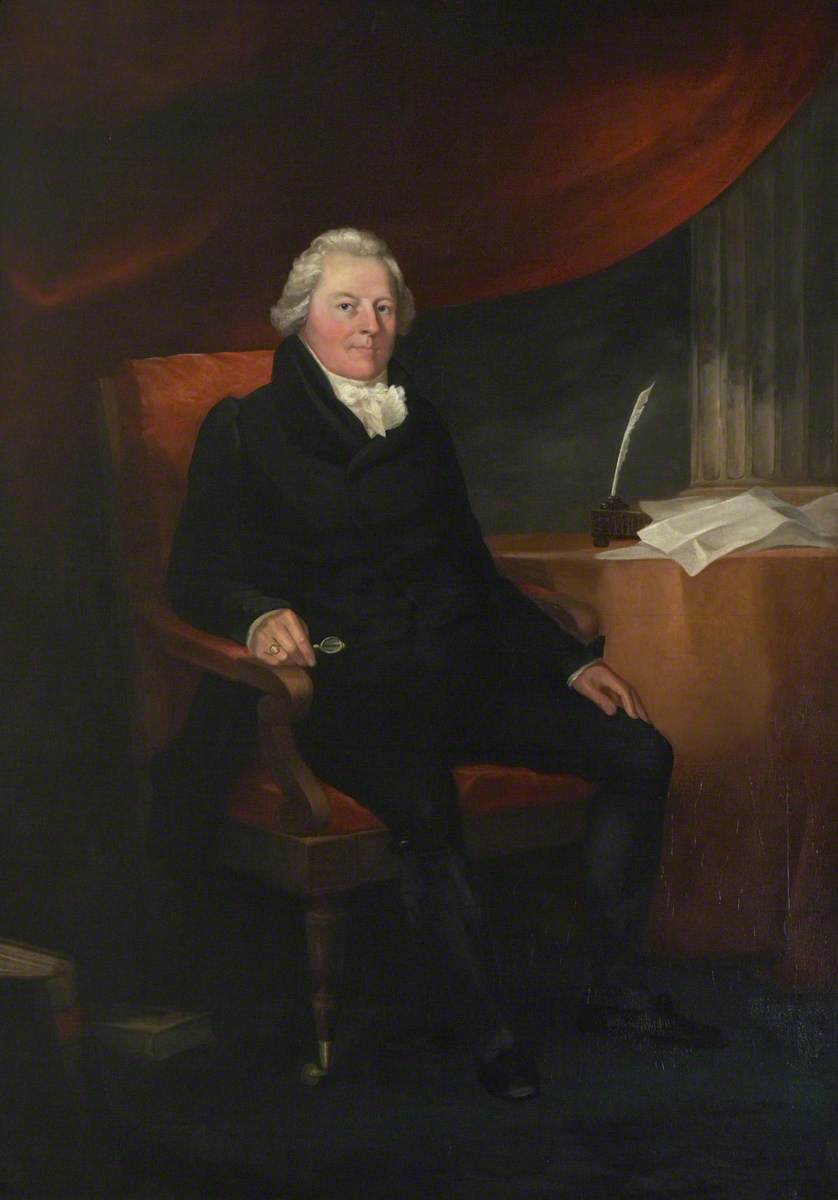
portrait of Provost William Inglis hanging in the Main Hall of Inverness Town House; attributed to Grigor Urquhart
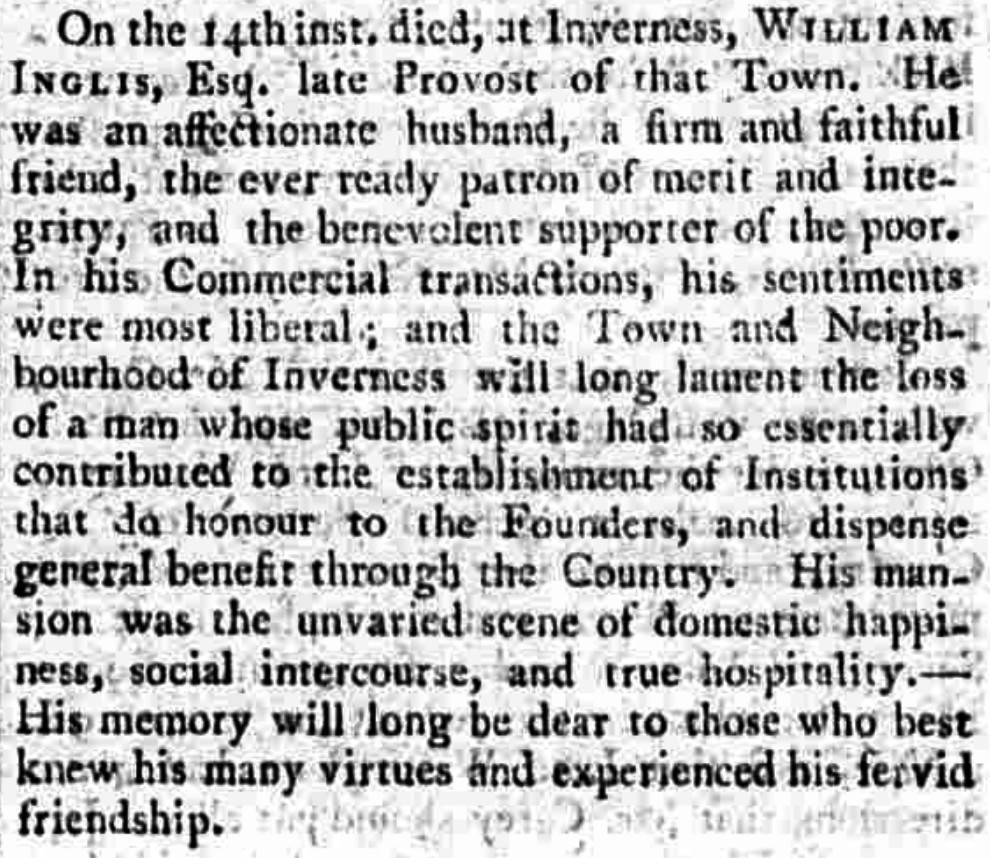
The London Sun 21 February 1801
William Inglis (1747–1801) was a merchant and banker in Inverness. He bought the small estate of Kingsmills. The original house is now incorporated in the Kingsmills Hotel. Inglis entered the Town Council at an early age. In 1780 he was made a Baillie and in 1791, as Dean of Guild, he was responsible for raising funds to build a new jail, court house and steeple. Only the steeple now remains. He was also the driving force behind the establishment of Inverness Royal Academy and the Northern Infirmary. In 1797 Inglis was elected provost, a post he held until 1800. Provost Inglis is particularly remembered for having entertained Robert Burns to supper at his home in September 1778.
Under Provost Inglis’ administration many of the buildings in Inverness, which had fallen into ruin since the Jacobite Rebellion, were repaired or rebuilt. In 1800 he persuaded the Council to build a retaining wall at the foot of the castle. Inglis Street is named after him. On his death, the newspapers eulogised him. What the newspapers did not say was that William Inglis had committed suicide by jumping off Ness Bridge, following the disappearance of his Bank Clerk, Andrew Fraser. The trial of Fraser later that year saw Fraser indicted for fraud and embezzlement but discharged to give him more time to prepare his defence, and I have been unable to determine his eventual fate.
It would be good to learn more about the life of Christian Urquhart, marrying Hugh Inglis quite late in life, and after his decease living in the New Town of Edinburgh and finally being buried in an adjacent plot to that of William Macao and Helen Ross. Let me know if you have any more information!
3. Elizabeth (Betty) Urquhart – did not marry. Sage records her as a devout, feeble old lady living at Burnside of Newhall, last mentioned in 1824, when William Macao asks Sage about her in Edinburgh. Sage describes William Macao and Miss Betty in his Memorabilia Domestica:
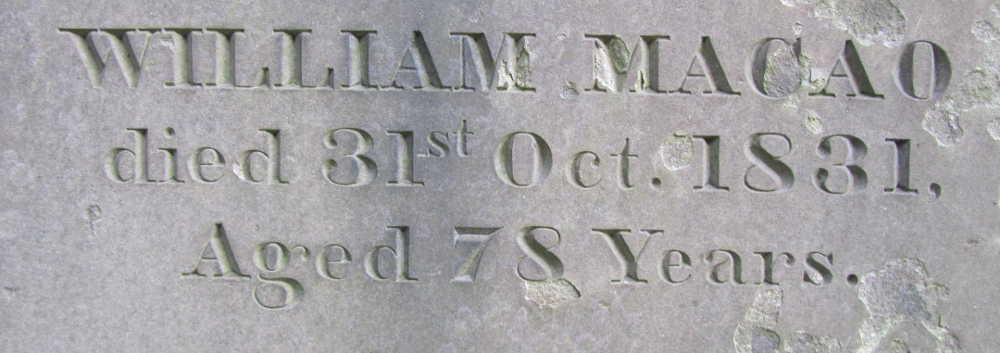
photo by Jim Mackay
When at the Assembly [in Edinburgh in 1824] I had a note from Mr. William Macao, a native of China, asking me concerning Miss Urquhart who resided at Resolis. Mr. Macao left his native country as the body servant of the family of Braelangwell in the parish of Resolis, and had, under Christian training, been reclaimed from heathenism to a saving knowledge of the truth as it is in Jesus. He held a situation in the Excise Office in Edinburgh, and in his note he expressed his desire to see me either at my lodgings or at No. 1 Dundas Street [home of the Board of Excise]. I called, and had a short but very interesting conversation with him. In his becoming acquainted with divine truth, he had been indebted to Miss Betty Urquhart [Dr David Urquhart’s sister], as to one among others who had been instrumental in leading his mind to right views on that all-important subject. He was married and had a grown up son.
Miss Betty Urquhart was the daughter of Mr. Urquhart of Braelangwell, and the sister of the late Dr. Urquhart, his son and successor. Dr. Urquhart studied for the medical profession, and went abroad, whether to China or India I cannot say. On his return to his native country he resided on his paternal estate, and soon afterwards, on the decease of Mr Lockhart who was married to the heiress of Newhall, by whom he had a family of sons and daughters, Dr. Urquhart became the second husband of Mrs. Lockhart, and had also a family by her. In the meantime, Miss Betty, as she was called, lived at Inverness. But long after her brother’s death, and after the estates of Newhall and Braelangwell had both been sold, she had an evident wish to end her days in her native parish. Her cottage was situated in a beautifully romantic spot on the banks of the burn of Resolis, and there she spent, in piety and peace, the few remaining years of her earthly pilgrimage. She had, however, some time before my settlement in 1822, been entirely confined to bed by age and infirmity. I frequently visited her, as did also both my sisters-in-law, and we certainly enjoyed the simplicity, humility, and heavenly-mindedness with which she recounted, in a retrospect of the past, “all that the Lord had done for her soul.” It would also be about this time that her niece, Miss Harriet Urquhart, paid her a visit. She lived usually with her relative, Mrs. (Col.) Lewis Mackenzie of Scatwell, in England, or at Rouen in France. When Miss Urquhart visited her aunt at Burnside we had the pleasure of seeing her at the manse. She was an amiable young woman, and seriously disposed. To Miss Betty’s comforts her niece was uniformly attentive. I have had several communications from her, containing remittances of money to be given to her aunt according as she stood in need.
Note that Sage says that Miss Betty had resided in Inverness before returning to Resolis. I do wonder if she lived with her sister Christian following her marriage to Baillie Hugh Inglis of Kings Mills, Inverness, in 1777 and perhaps returned to Resolis after Hugh Inglis died in 1782 and sister Christian moved to Edinburgh.
4. Jean Urquhart – did not marry, and was alive in 1809 when brother David wrote the deed contained in his will which provides an annuity to her. I have no information on where she resided.
5. David Urquhart of Braelangwell (c1748–1811) married Henrietta Gordon in 1786 and Margaret Hunter in 1804 – for his children see here.
6. Lillias Urquhart (c1748–1822) married Farquhar MacDonald, Land Surveyor of Customs in Inverness, in 1775. From Farquhar’s will, there were two children who survived him, Captain William Macdonald amd Lilias Thomson ms Macdonald.
“Land Surveyor of Customs” sounds like an innocuous enough job, but in reality it was at the front line of the perennial battle against smuggling. I see one case (JC26/1807/7, 1807) when Donald McKenzie, changekeeper in the Black Vennel of Inverness, John McGregor, sawyer in Inverness, Duncan Mackay, in Milnbuy, John Fraser in Spittal of Redcastle, and John Lobban, lately residing in Ballicladdich of Tarradale, were prosecuted for the crime of deforcement. It was libelled that on the night of 20 March 1807, Farquhar McDonald, land surveyor of the customs at Inverness, witnessed a number of people carrying into a cellar several casks or ankers from a boat at the shore of Inverness which, on inspection, contained smuggled spirits. Assisted by his three assistants Alexander Fraser, tidewaiter, John Cumming, landwaiter, and Alexander McIntosh, landwaiter, the goods were seized and McDonald and his three assistants were subsequently violently assaulted by the Pannels, and the casks or ankers were forcibly taken from them and carried away. MacGregor and Mackay were found guilty. The work of a land surveyor of customs was a risky one!
The couple are buried in Chapel Yard, Inverness.
Chapel Yard memorial
In memory of Mrs Lillias Urquhart, spouse to Farqr McDonald, Land Surveyor of Customs, who died 16th December 1822, aged 74 years, and himself, who died 16th January 1838, aged 88 years.
GET PHOTO OF CHAPEL YARD MEMORIAL
Charles Urquhart as Trustee and Factor of the Creditors of
Sir George Mackenzie of Grandville, Proprietor of the Estate of Cromarty
Charles Urquhart of Braelangwell was of course related to all the landed Urquharts of the north. Captain John Urquhart of Cromarty and Craigston (previously known as Captain John Urquhart of Craigleith) acquired the Estate of Cromarty in 1743, it having come to a judicial sale due to the debts of the previous owner, Sir George Mackenzie of Grandville .
Charles had been appointed as a trustee and as factor for the creditors of Sir George Mackenzie of Grandville and hence was managing the estate of Cromarty for them. But before it was sold to Captain Urquhart, Charles had been keeping him appraised in detail as a potential purchaser of the estate.
Within the Urquhart collection in Craigston Castle there is a wonderful letter from Charles, extracts of which I set out as it shows the detailed knowledge Charles had as to what was happening on the estate, but more interestingly includes considerable personal information. Going to the country to take goat’s milk was a popular cure for ill-health, and Margaret, the wife of Charles, and another wife of an Urquhart, had been in Strathspey on the cure for a month. Charles and his Urquhart companion were about to go to pick them up. They had bad news to deliver to their wives. Mrs Urquhart had a son Roderick who had died just as he was nearing China. And Margaret was also going to receive some bad news – her brother John Munro had died in the East Indies.
[address] Capt. John Urquhart of Knockleith Esq / to the Care of Leonard Urquhart writer to the Signet under Greenhills Court
[content] … the agreeable Accts. of your Ladies being safely brought to bed of a son … I doubt not but you heard of David McCulloch Writer at Ed[inburg]h. his being sent North by order of the Lords to make up a true & genuine Rentall of Sir Geo’s Estate [Sir George Mackenzie] [Braelangwell goes on to list great number of imperfections on what was done, two examples being] … Wil: McCulloch Woodsyde by his own confessione to myself has taken in new Land, 10 Bolls Soweing & David McCul: in Davidstowne 7 Bolls Do. Besides there might be a Dale improven in the Hill to Little Charges;
…
I wish this may find you at Ed[inburg]h. This afternoon I expect Mr Urqt at Cro: [Cromarty] in order to proceed then for Both our Wives, have been the Moneth past at the Goatmilk in Strath Spey, But to Mrs Urqrt’s additionall afflictions, I have a letter from London dated 10th Curt. showeing that 10 Dayes before then, Tho. Harrison & Martin Commander came in to the River, wt. qm poor Rodk saild for China, died on his outward passage by a Swelling in his Throat qch moressed, till found there was a necessity for making ane Incessone This gave him some ease in the meantime & some hopes to Others of his Recovery, yet died near China where he was decently buried end of Augt. last. I’ve just as meallancholly accot. for my wife of the certainty of her Broyer John [Munro]’s death in East Indies, who I hear has made his will wholly in favoures of his Broyer Inverchassly [David Ross] & a Commerade he had there. This Inverchassley does not condescend on, tho he writes me that he got an Extract of his Broyers Will; Whatever truth is in this, coud the certainty of it be found out by any Frende of mine so as neither to be seen in it, I would be well satisfyd to offer you that piece of trouble; if there be any Hopes of trusting threin, more then in the Generousity of Broyer likes money so well. This goes under Cover to Leonard to waite your upcoming as Mr Urqrt informs me to you I heave suggested the meallancholly tidings …
Brealangwell 27th June 1738 Cha: Urquhart
As mentioned, Charles obviously did not trust Margaret’s brother, David Ross of Inverchasley, an inch where money was concerned!
In a postscript he reveals that he, when selling the crop from the Estate of Cromarty to Baillie Stewart in Inverness, had suffered a considerable loss, presumably because Baillie Stewart could not pay him in full and as factor and trustee he had to bear this loss personally.
PS Im Sorry to tell you yet that Im like to be a hearty sufferer by the sale of 600 bolls to Baillie Stewart at In[vernes]s of Sir Geo’s fermes Crop 1736 as I trusted too much in the name of an honest man never hade vissable losses besides … favours to him, gave me too much encouragement to it, our friend Leonard knows this fully so I beg part as above
That same Baillie Steuart kept a copy of his correspondence in a series of letterbooks which have survived. Portions were published as Letter-book of Bailie John Steuart of Inverness 1715–1752 edited by William Mackay (Scottish History Society, 1915). And sure enough, the debt to Charles Urquhart of Braelangwell comes up on several occasions.
12 Nover. 1737.
I wrot this dait to Leonard Urquhart annent my affair with [Urquhart of] Brealanguall
Inverness, 26 October 1741.
Mr. Rodrick Mackleod, writer at Edr.
Dr Sir,– This letter will be delivered you by Charles Urquhart of Brealanguel, to whom I am indebted, and who has accepted bills of mine to the extent of about £70 ster. And, as I have no way at present to satisfy him for the same, I have made a proposal to give him that bond resting by Baillie Robert Rose, Father to Henry Rose, to Janet Carr, my present wife’s grandmother, to which she made title by your manadgment. But, as the expence of making title is not payd, I suppose Brealanguel will pay the same ; and on such payment you’ll please give him up the bond on getting his obligatory recept promising to account to me for what he recovers by the said bond in part payment of my bills in his hands, the dait of the bills and sums in them to be mentioned, as I suppose he is to indorse them to others, being due to him as trustee and factor for Sir George Mackenzie’s creditors, for a part of whose rents these bills were granted. So I must depend on you to order this affair as you find most safe for my interest; but I think it will be proper this bond be put in such hands as will do the meedful on it lest longer delay occasion the loss of the whole subject; which at present is all from, etc.
I don’t see another reference to the debt after this so I’m assuming that Charles was largely recompensed for what he had lost as trustee and factor for the Estate of Cromarty.
Charles and the Church and “The Lamb of Cullicudden”
As a resident proprietor, Charles attended Presbytery frequently to hear claims against the proprietors – pro rata, land-owners were legally required to maintain church, manse and the minister’ steading and were liable for other expenses. However, I don’t see him engaging with the actual religious processes, unlike, say, Alexander Gordon of Ardoch who became a ruling elder. Given that he included ministers within his predecessors it is quite surprising that Charles kept well away from direct involvement with the Church.
This is all the more curious as his sister Anne or Anna married the Reverend Thomas Inglis, minister of the united parish of Kirkmichael and Cullicudden. Thomas, known as “The Lamb of Cullicudden” for his meekness and gentleness, was the local minister for 32 years, from 1715 to his death in 1747. He married Anne in 1725; she died in 1742. Their wall memorial at Cullicudden Burial Ground is quartered with the three boar heads of the Urquharts.
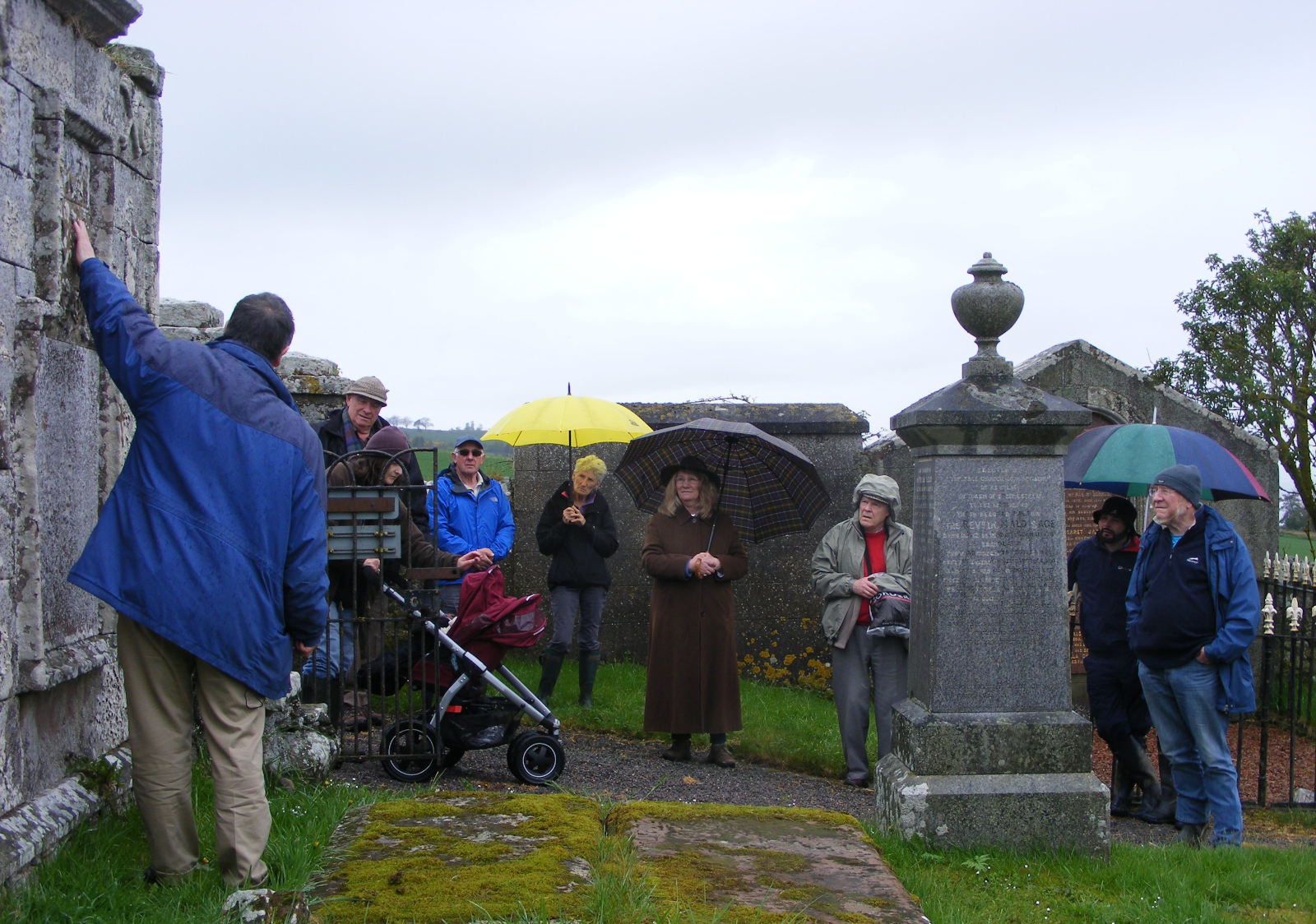
the Reverend Thomas Inglis/Anne Urquhart heraldic panel highlighted during a guided tour of Cullicudden by the Kirkmichael Trust; photo by Verity Walker Eley
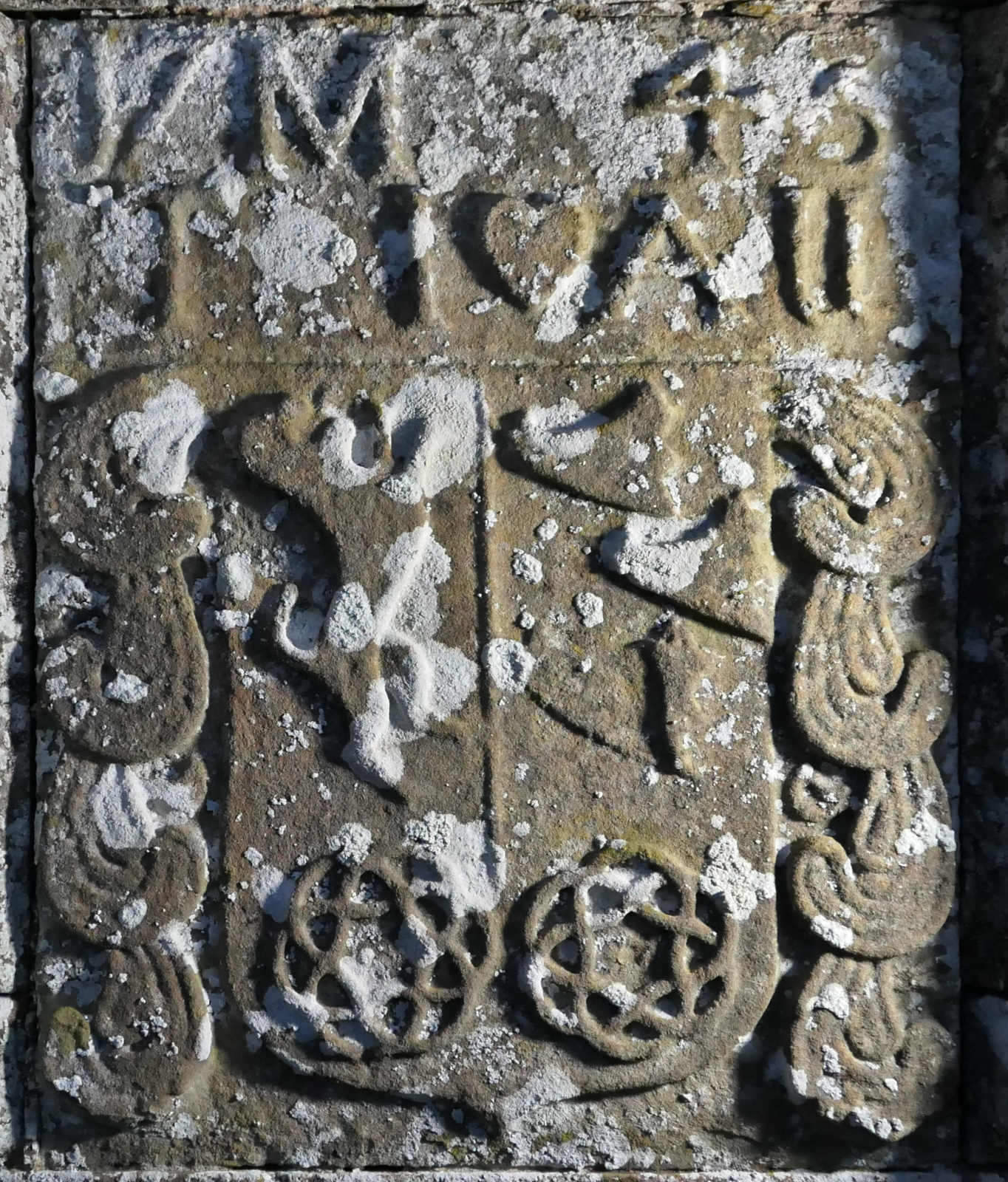
photo by Jim Mackay
Thomas may have been known as “The Lamb of Cullicudden” but the Inglis crest on his memorial panel in Cullicudden is that of a lion rampant! The Urquhart three boar heads are for Anne Urquhart of Braelangwell. The inscription on the panel is simply “17M 45 / TI AU” (the “MTI” representing Master or Magister Thomas Inglis). The “1745” indicates the memorial was erected after the death of Anne, but before Thomas himself had died. There is a panel in Latin underneath. As well as the wall memorial, Thomas Inglis is commemorated in Cullicudden on the Reverend Donald Sage pillar (seen on the right of the photograph above left) and on his own low tablestone. Anne or Anna Urquhart is also commemorated separately on an adjacent low tablestone. The text runs around the perimeter and, with some ligatures, reads: “Under this stone lies the bodie of ANNA URQUHART spouse to Mr THOMAS INGLIS who departed this life the 31 day of July 1742 in the 43 year of her age My flesh shall rest in hope.” These two tablestones may be seen beside the legs of yours truly in the photograph above left!
Thomas and Anne had four children, William, who died out in Jamaica, Anne, who married the Reverend James Calder, Minister of Croy, and John and Jean, who were still youngsters when Thomas died. The presbytery records pick up on the story:
At Rosemarky [19 July 1748], upon application from John & Jean Children to Mr Thomas Innes Shewing that they were within the age of pupillarity at the Time of their father’s Death & still continue minors & being without Tutors or Curators for want of which they have not access to recover payment of the Quotas due them out of the publick Fund for a provision to the widows & children of ministers &c And craving that the Presbyteries as by Law impowerd would appoint curators for them, for this purpose. The Presbytery considering the said Desire & finding it reasonable did & hereby do nominate & appoint Mr William Inglis Baillie in Nairn & Charles Urquhart of Brealangwell Uncles to the said Children & Mr James Calder Minister at Croy their Brother in Law to be their Curators for the said purpose.
Those were the daughters. Son William Inglis had sought his fortune in Jamaica – but like so many others had perished there. The family did not know exactly when he had died, but in 1750 moved forward to claim the money which had been owing to William from the same fund. Charles Urquhart had agreed to be cautioner, always a dangerous role, as he would have become liable himself if there was a problem. However, he was clearly happy to assist his nieces.
Testament Dative and Inventary, William Inglis, 13 December 1750
The Testament Dative and Inventary of the debt and sum of money pertaining and addebted to umqll. William Inglis lawfull son to the deceast Mr. Thomas Inglis late Minister of the Gospel at Kirkmichael and Cullicudden the time of his decease who deceased in Jamaica upon the [blank] day of [blank] Mvii& and fourty [blank] years faithfully made and given up by John and Jean Inglis’s brother and sister german to the defunct and by Mr. James Calder Minister of the Gospel at Croy husband to and as having best knowledge in name and behalf of Ann Inglis his spouse also Sister german to the said defunct which John Anne and Jean Inglis’s are only Execrs. Dative qua nearest in kin decerned to the said umqll. William Inglis their brother german and that by Decreet of the Commissarys of Edinburgh as the samen of date the fourth July Mvii& and fifty years in itself at more length preports. In the first the said umqll. Wm. Inglis had pertaining and addebted to him the time forsaid of his decease the debt and sum or money underwritten vizt. the sum of Sixty one pounds five shillings one penny two thirds Sterl. as the sum and proportion which had fallen due and accresced to him upon the decease of the said Mr. Thomas Inglis his father by Act of parliament for establishing a fund for the widows and children of ministers of the church of Scotland… Cautioner Charles Urquhart of Braelangwell in the parish of Kirkmichael and County of Cromarty dated the thirteenth December Mvii& and fifty
Many years later another sister of Charles, Christian Urquhart, would marry Baillie Hugh Inglis of Inverness as his third wife. The father of Baillie Hugh Inglis had come from Nairn, and you will note the uncle of the orphaned Inglis children was Mr William Inglis Baillie in Nairn, so I think we can assume these various Inglis representatives were from the same Nairn family.
Charles Urquhart and Politics
Charles Urquhart of Braelangwell became closely involved in the partisan political struggles of the time. In this he found himself in conflict with his closest neighbours, the Gordons of Newhall. In one particular sneaky move, he sought to have William Gordon of Newhall struck off the voting list as he was too young. The next generation saw a joining of forces as his son David married Henrietta Gordon of Newhall, young William’s sister! But we’ll come back to his political machinations.
The most controversial political battle was around the Shire of Cromarty election of 1768. In this, the richest man in Britain, Lord Pulteney, bought the Cromarty Estate in order to purchase enough voting power to contend in the election. His rival was the irascible Sir John Gordon of Invergordon, who had been arranging with friends and relatives nominally to sell and distribute that element of their land ownership that conferred voting rights to maximise his number of votes. If you study the sasine register for that period, you will see many transfers of land which are all spurious – they are merely to create votes. This activity was quite legal, but each side examined minutely each and every transfer of land, and even the rights of the original owner, and would legally challenge the slightest discrepancy to prevent someone from being added to the all-important Roll of Freeholders.
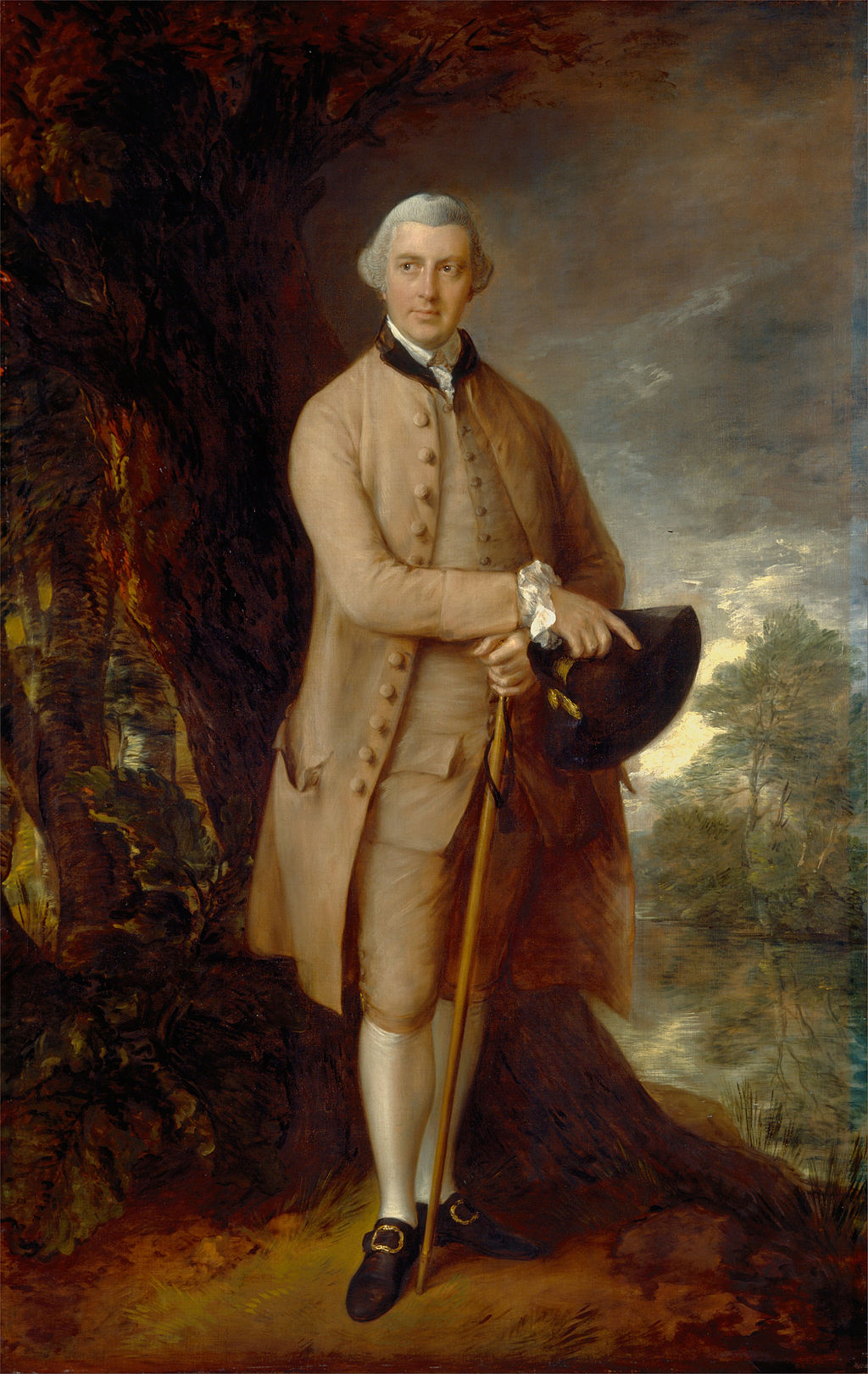
William Johnstone, Lord Pulteney, by Thomas Gainsborough
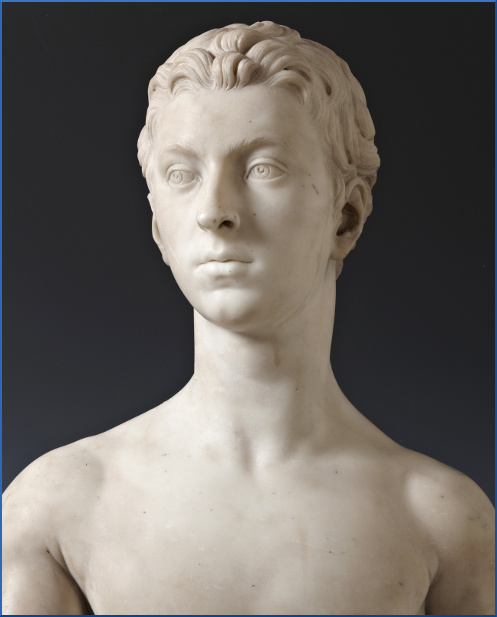
Sir John Gordon of Invergordon, byEdmé Bouchardon
The Trump/Biden election of 2020 had nothing on it. In one challenge, evidence from the registrars of every sasine registry in Scotland was sought to prove a point of sasine registration practice.
The body who initially adjudged on changes to estates in this context, calculating the valued rents (and thereby creating more votes), was the Commissioners of Supply for the Shire of Cromarty. There was intense competition to become the Preses or chairman of these Commissioners and to pack the body with supporters of a particular cause. Charles Urquhart was a Commissioner and at times the Preses, and was very much a Lord Pulteney man.
Commissioners of Supply Minutes, at Cromarty, 22 May 1765
[Henry Davidson of Tulloch (another Lord Pulteney man) is elected as Preses, but there are a host of objections and counter-objections to those voting.]
Thereafter Charles Urquhart of Braelangwell produced Extract age of William Gordon [of Newhall] – under the hand of James Craig Designing himself Clerk to the Church Sessions and keeper of the Records of Baptisms and Marriages of the City of Edinburgh (and which is now marked by the Preses & Clerk, and ordained to be a part of the Minute) and objected against the vote of the said William Gordon of Newhall in Respect that it appeared from this Extract That he will not be of age till January next – Haveing been born on the fourth day of January one Thousand Seven hundred and Forty five, of which Extract the tenor follows, “Edinburgh the fifth day of January One Thousand seven hundred & forty five years, There is Registrate for Baptism to Mr. Charles Hamilton Gordon advocate and Mrs. Hellen Cunningham his Spouse, a son named William witnesses, Mr. Robert Dundass Senior of Arriestown one of the Senators of the Colledge of Justice & Doctor James Stevenson Phisician in Edinburgh, the Child was born the fourth day instant and Baptised by Mr. Alexr. Webster one of the Ministers of this City Extracted from the Records of Baptisms of the City of Edinburgh, By me Clerk to the Church Sessions and keeper of the Records of Baptisms and Marriages of the said City by (signed) James Craig Session Clerk.” On the back of which is written thus, “Cromarty 22d. May 1765. This is the Extract as to Mr. Gordons age Referred to in the minutes of this date (signed) Henry Davidson Pr. Geo: Greig Clk.&rdquo. To which answered for Mr. Gordon that the paper now produced Called and Extract signed James Craig can bear no Testimony here In Regard that it is not properly authenticated and therefore Justly to be Considered, as of no Importance as alien to the present case, And Giveing, But not Granting, That the paper is Genuine, It is not a proper prooff, of what it imports, That the objection cannot stand against Mr. Gordon, unless a Judiciall prooff of the Evidence of Honest people be instanter adduced On which The said Charles Urquhart observed That he would Supply a Defect if any in the Extract produced, By the oath of Mr. Gorry himself, and of William Baillie of Rosshall Esqr. now present–
After recourse to law, it was agreed that William Gordon of Newhall would be allowed to become a Commissioner of Supply but would not be entitled to cast a vote in their decisions until he reached the age of 21!
Charles Urquhart of Braelangwell and William Gordon of Newhall despite being close neighbours were thus on opposing sides in this war. The next ploy of Charles was again directed at William Gordon of Newhall. Braelangwell had sold an area of land to William&rsqyils father, Charles Hamilton Gordon of Newhall, and in order to prevent William from inflating its value, and also to update his own valuation, Charles sought a formal valuation of Braelangwell and the parcel he had sold. Thus at the meeting of 4 June 1765 we read:
Then a petition was presented by Charles Urquhart of Braelangwell Stating the Sale of a Small parcell of his Lands of Braelangwell Called the Smiddy Croft made some time ago by him to Charles Hamilton Gordon of Newhall Esquire Deceast and praying the Commissioners to Grant warrand for serving this petition on William Gordon Esquire son & heir of the said Charles Hamilton Gordon and upon his Curators, and they to put in answers to the same and to Grant Warrand for sending Witnesses, for proveing the Rent of the several lands and all other Facts necessary and to Divide the Valuation mentioned in said petition according to Law…
In order to prove the rent, the various tenants of Braelangwell were examined. There are very few records of the Braelangwell Estate extant so these statements are invaluable. Thus we have, for example:
[9 October 1765] Compeared Alexr. Hossack in Cullbalochy married aged fifty or thereby who being Solemnly Sworn purged of partiall Councile Examined and Interrogate Depones That he has been in Culballachy part of Braelangwell’s Estate for near Twenty years, That he pays yearly, Twelve Bolls Three Firlots meall & Bear Two Bolls of Oats That he pays Ten Shillings one penny & eight twelfths Sterling of Money beside one penny Sterling per Boll of Vicarrage half a wedder, Eighteen hens, Forty Windlins of Straw, Forty Loads of Fireing & forty eggs and one merk Scots per Boll as the Conversion of Services, And with Respect to the Conversion of Wedders and hens Depones cum precedente And that five firlots of Oats is equal to a Boll of Meall or Bear, And as to the Rent of Alexander MacConachies Possession Concurrs with the Preceding witness, And with Respect to the Rent of the Lands in Braelangwell's own Possession Depones cum precedente in omnibus– Causa Scientise patet and this is truth as he Shall answer to God Depones he Cannot write (Signed) Hugh Roses P. Geo: Greig Clk.
I include this particular tenant of Charles Urquhart simply because, at time of writing, at our most recent Kirkmichael Work Party a few days ago we uncovered a previously unrecorded, buried slab – commemorating none other than this very Alexander Hossack, and his spouse, Isobel Holm!
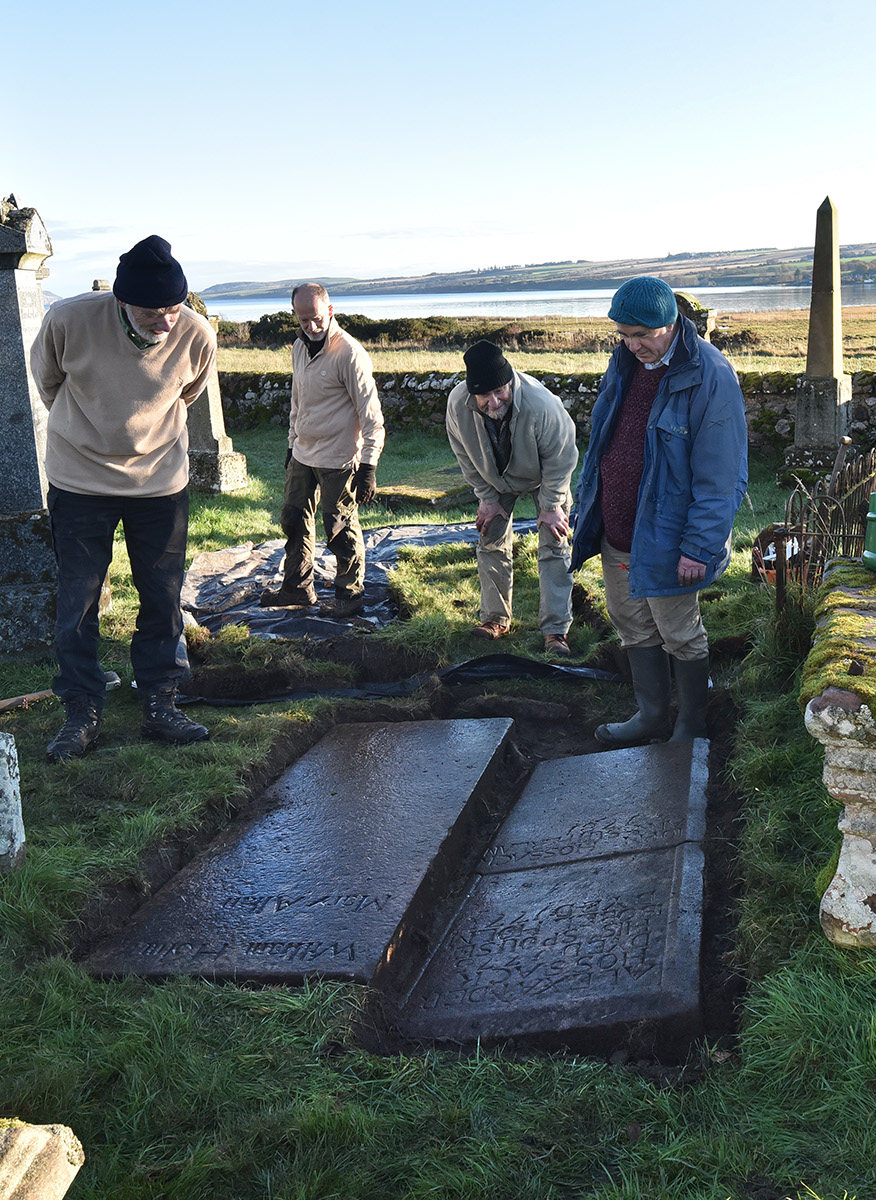
photo by Andrew Dowsett
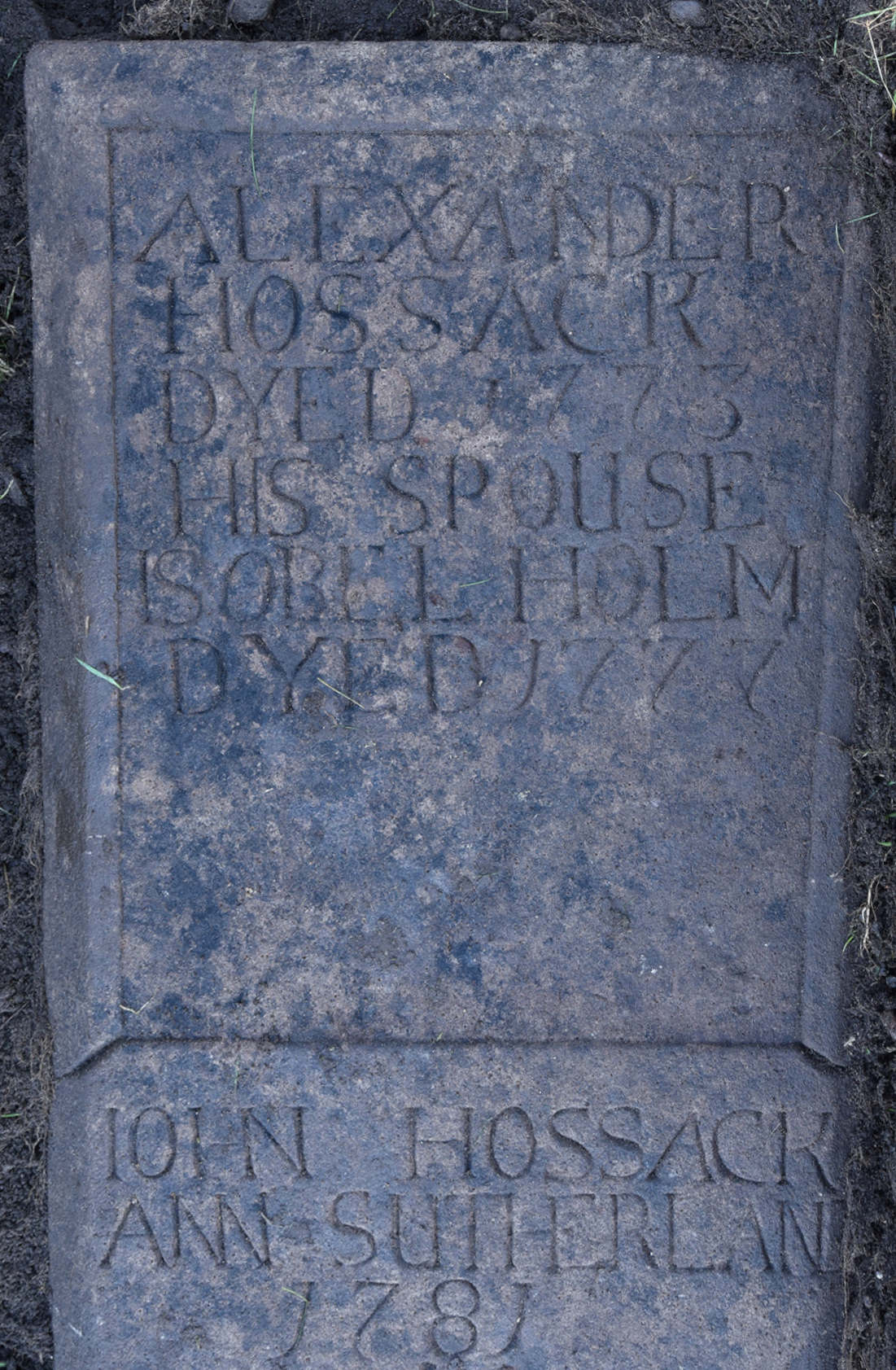
photo by Andrew Dowsett
In the event, Lord Pulteney won the election in 1768, and Sir John Gordon spent a fortune he didn’t have in disputing the result in court. I presume that Charles Urquhart of Braelangwell benefited directly. It was such a tightly fought battle that Lord Pulteney would not have succeeded without his support.
Death
I don’t know when Margaret Ross died, but the death of husband Charles Urquhart was reported in the press:
1776 … July … 27. At his house in Rossshire, Charles Urquhart of Braelangwell, Esq;

Scots Magazine July 1776
I imagine examination of the sasines around this period would provide more information surrounding the inheritance. We know David, the Surgeon Major, was still in Bengal in 1784 when he had Sophia baptised.
David Urquhart of Braelangwell (c1748–1811)
More on the life of David Urquhart of Braelangwell is set out in my complementary story on his children here, and this is a recap of some of that material.
Dr David Urquhart was a refined, literate, gracious man. I think much of the layout and style of the chancel at Kirkmichael is due to him. The simple sandstone panel commemorating Anna MacCulloch, his grandmother, is filled with his flowery language, now only readable using photogrammetry. The marble panel on the west wall of the chancel at Kirkmichael commemorating Henrietta Gordon, his first wife, is overflowing with his style. The inscription on the panel beside it erected by Ann Anderson to Charles and the other Lockhart boys has his hand written all over it.
His own panel, on the east wall of the chancel, was erected by his only son born to Henrietta, Charles Gordon Urquhart. It reads:
Sacred to the memory of DAVID URQUHART, Esq. of Braelangwell, who departed this life January 11th, 1811, aged 63. He married, in 1787, HENRIETTA GORDON of Newhall, who died, leaving him a son and a daughter. In 1804 he married MARGARET, daughter of JAMES HUNTER, Esq. of Edinburgh, by whom he left a son. In the discharge of every Christian and relative duty he filled with dignity, the sphere assigned to him in this world, till removed by Providence to a better. In fond remembrance of his eminent worth and exalted piety, his sorrowing widow and grateful children thus bear testimony to his virtues.
“The righteous shall be in everlasting Remembrance.” 112th Psalm, V. 6
Erected by his affectionate son, CHARLES GORDON URQUHART, Esq.
David Urquhart’s birth year is usually given as 1748, based, presumably, on his age when he died. The above memorial in the chancel at Kirkmichael says he departed this life “January 11th, 1811, aged 63” giving the said birth year of 1748, or perhaps more likely 1747.
David attended King’s College Aberdeen to become Master of Arts, and followed this up with medical training at the University of Edinburgh.
The Roll of Alumni in Arts of the University and King’s College of Aberdeen, 1596–1860, published by the University of Aberdeen in 1900, shows him on the MA course from 1760 to 1764. These dates might throw some doubt on his alleged year of birth, if it were not known that this age was not unusual for young men taking a University course at this time. The biographer James Boswell, who enters this story later, was enrolled on the arts course in the University of Edinburgh at the age of thirteen. Originator of the Statistical Account of Scotland, Sir John Sinclair of Ulbster, who also crops up in this story, was enrolled in the University of Edinburgh at the age of eleven.
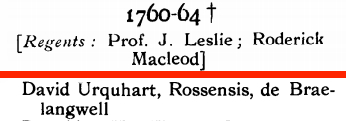
The classical grounding in Aberdeen was followed by specific medical training in Edinburgh. Information on Edinburgh University medical alumni held on the University’s website at https://collections.ed.ac.uk/alumni/record/76775 (accessed 3 December 2020) states that a David Urquhart was a “student of medicine” there, with a first year of study of 1764. It then states “Indian Medical Service 1767”. Given that we know David Urquhart of Braelangwell did indeed serve as a doctor in India then this must be he.
His first (natural) son David was baptised in Resolis in 1770, according to a signed statement by the minister of Resolis, the Reverend Robert Arthur, and the Session Clerk. The statement was needed to confirm David junior’s age when later joining the Honourable East India Company’s military service, in which he would unfortunately die in 1800. The baptism must have been private as it does not feature in the parish Baptism Register. Now, if the Edinburgh University record is correct in stating that he was serving in the Indian Medical Service 1767, then it may well be that young David was born out in India and was baptised when David senior was back home in Scotland on leave.
The book Eighteenth Century Medics: Subscriptions, Licences, Apprenticeships by P.J. Wallis, R. V. Wallis, J. G. L. Burnby and T. D. Whittet (1988) provides a one line entry: “1780 Urquhart, David, surgeon, Bengal”. That will be our David. The next definite record we have of him in India is on the baptism of another (natural) child, Elizabeth Sophia, in Calcutta, Bengal, on 10 December 1784. At this time he is given as “Surgeon Major” so he had reached a senior position in the military. Sophia is mentioned in her father’s will and a short history of her life is set out in our complementary story.
His father had died in 1776 so given David was still in Bengal at the baptism of Sophia in 1784, he had continued in India in his position for a long time after inheriting Braelangwell. We know he was back in Britain in 1786, though, as he married the widowed Henrietta Gordon in April of that year. Given he was in Calcutta on 10 December 1784, and as the voyage from India to Britain via the Cape of Good Hope took six months at least, then he must have made the voyage home from India during 1785.
The Caledonian Mercury of 29 April 1786 simply reported: “Married, David Urquhart, Esq; of Braelangwell, to Mrs Lockhart of Newhall.” The date within April was not given. The couple would have known each other in Edinburgh, where they both resided for periods, and in the Black Isle, where Braelangwell House and Newhall House are less than a mile apart.
David Urquhart maintained a residence in Edinburgh, in the New Town. Indeed, he appears to have obtained this before he returned to Britain, as I see in Williamson’s Directory for the City of Edinburgh, Canongate, Leith, and Suburbs: From June, 1784 – To June, 1785 (published in 1784):
Urquhart David of Braelangwell, No 49. George’s str. south side
This entry recurs in the Directory for 1794/1795. However in the 1800/1801 Directory I see a re-location to the Old Town:
Urquhart, David Esq; No 36. George’s square
Into the bargain, I see an advert in the Caledonian Mercury of 11 January 1787 and subsequent dates, offering for sale or let a property (clearly of some size) currently in the possession of David Urquhart of Braelangwell, located at the back of the Canongate, just off the Royal Mile. He had married Henrietta Gordon of Newhall the previous year, and perhaps this residence was now surplus to requirements.
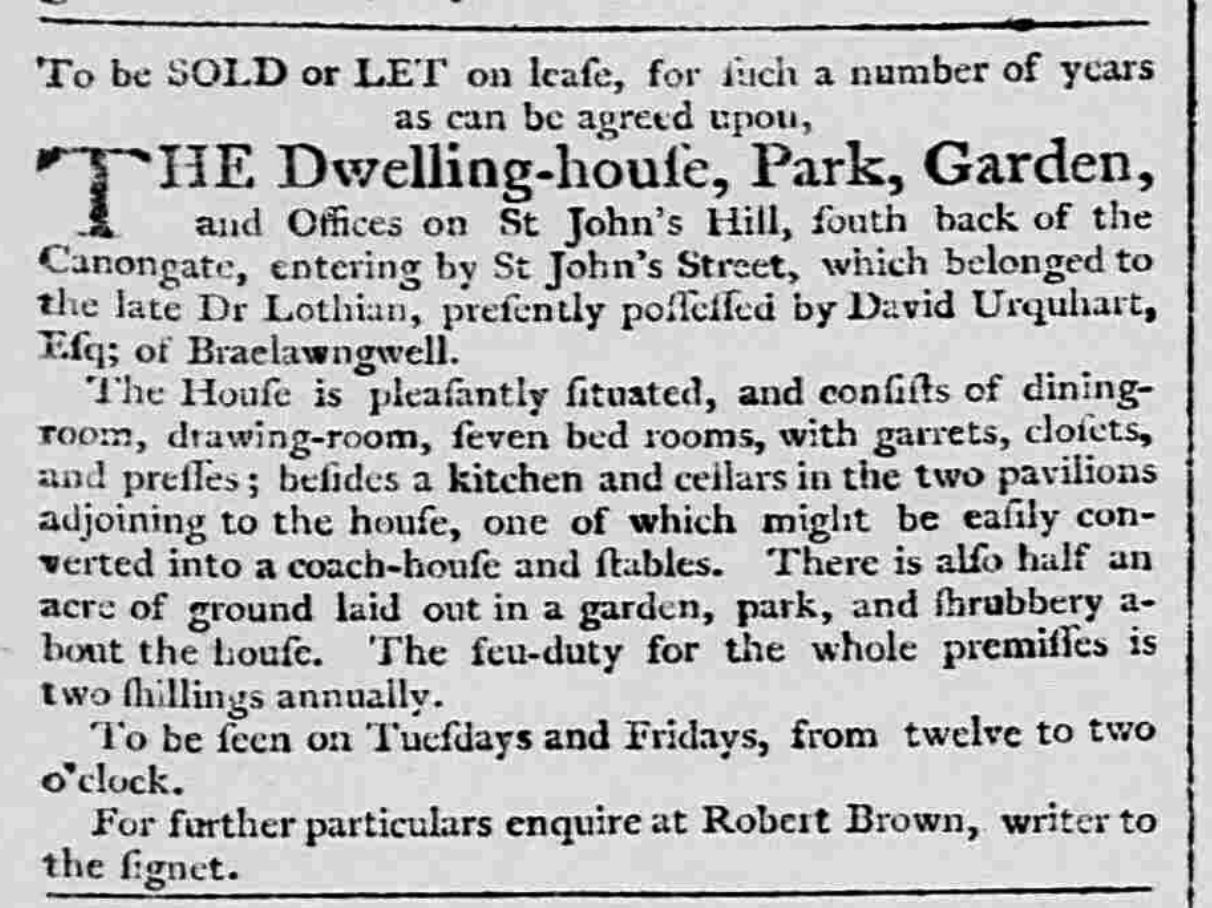
Caledonian Mercury 11 January 1787
From the frequency of records when he is recorded as being at Braelangwell, I should have thought that his maintaining a residence in Edinburgh was an expense that could have been dispensed with. But I imagine his social position would have necessitated the Edinburgh home. The only intrinsic income that lairds had was the rents from their tenants, and there is no way that a small estate, even one as fertile and well-maintained as Braelangwell, could ever sustain this way of life.
Part of the pleasure of residing in Edinburgh, of course, would be the mingling with the social elite of the time. I have no information on David’s enterprise in that area, but we have some evidence of Henrietta’s experience whilst wife of Commissioner Thomas Lockhart. That evidence comes from no less than the diaries of James Boswell, the writer of the greatest biography in the English language, his Life of Samuel Johnson.
Henrietta had married Thomas Lockhart in 1725. They lived at 23 George Square in the fashionable New Town. I am grateful to Barclay Price for identifying James Boswell’s journals as a source of information on the Lockharts’ social life. One entry in James Boswell’s diary for 31 January 1776 records:
The Earl of Caithness, for whom I had been counsel and of whose family my ancestor Thomas Boswell’s mother was a daughter, was now in town. My lameness was an apology for my not visiting him. He and his second son (a lieutenant in Fraser’s Highlanders), Commissioner Lockhart and his lady, Miss MacLeod of Raasay, Dr. Boswell, Mr. and Mrs. Mitchelson, and Mr. Wood, the surgeon, supped with us. Lockhart has been very obliging to me in granting solicitations for offices in the Excise, yet by the most unaccountable negligence I had never once waited on him. My wife had been latterly introduced to Mrs Lockhart [i.e. Henrietta Gordon], and we sent them a card to sup, after my wife had called and my lameness had been mentioned. It was very kind in them to come. I was in excellent spirits.
Of the other guests invited by Boswell to dine with him, the Earl of Caithness he felt disliked him but pretended otherwise. Boswell probably would have met “Miss MacLeod of Raasay” back in 1773 when he and Samuel Johnson were guests at Raasay House as part of their Tour of the Hebrides. The Lockharts were clearly a diplomatic invitation given that Commissioner Lockhart was amenable to requests for placements in the Excise, but Boswell clearly liked their company. He subsequently called in to the Lockharts’ George Square home quite often for tea, and his diary entry for 19 April 1780 records an evening meal.
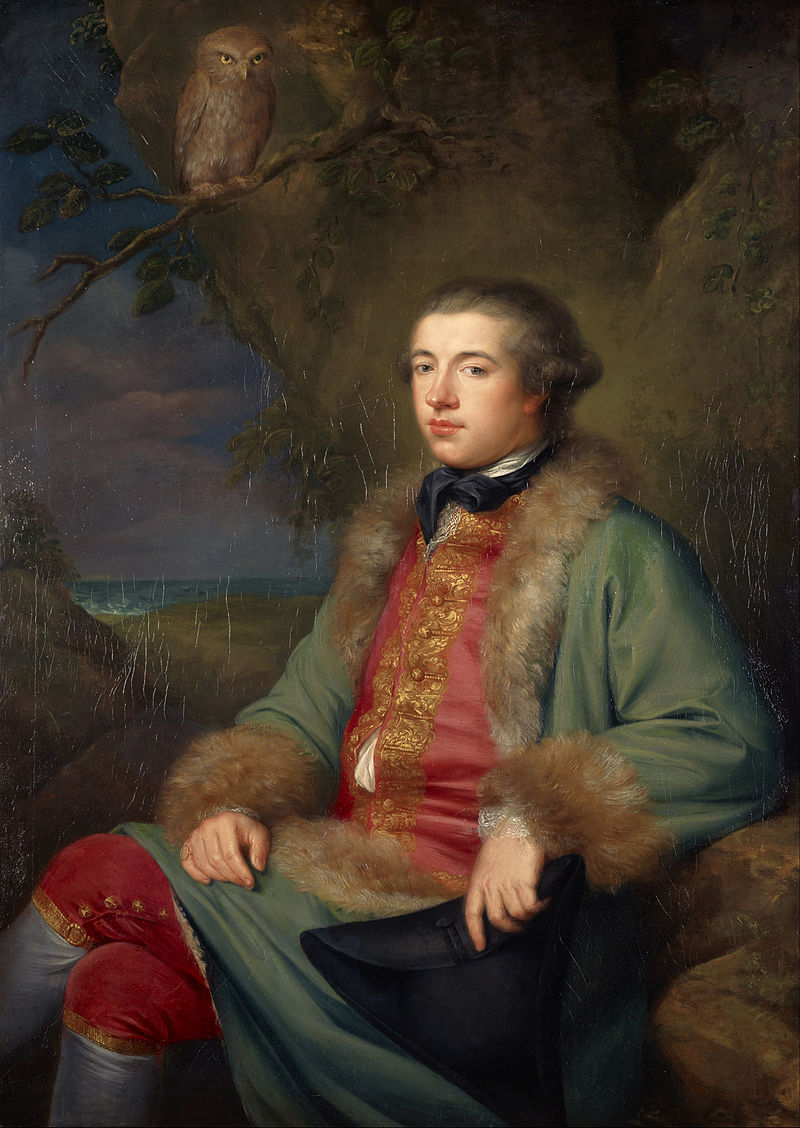
James Boswell painted by George Willison in 1765; Creative Commons Licence
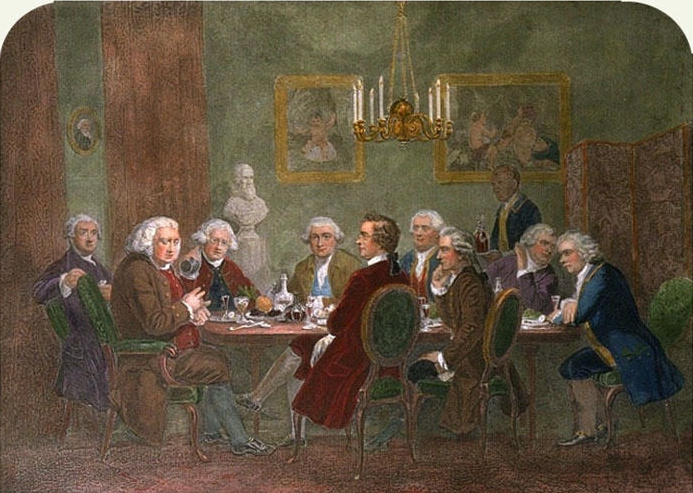
James Boswell (on far left) at “Joshua Reynolds’ Party” painted by D. George Thompson many years after the event; Creative Commons Licence
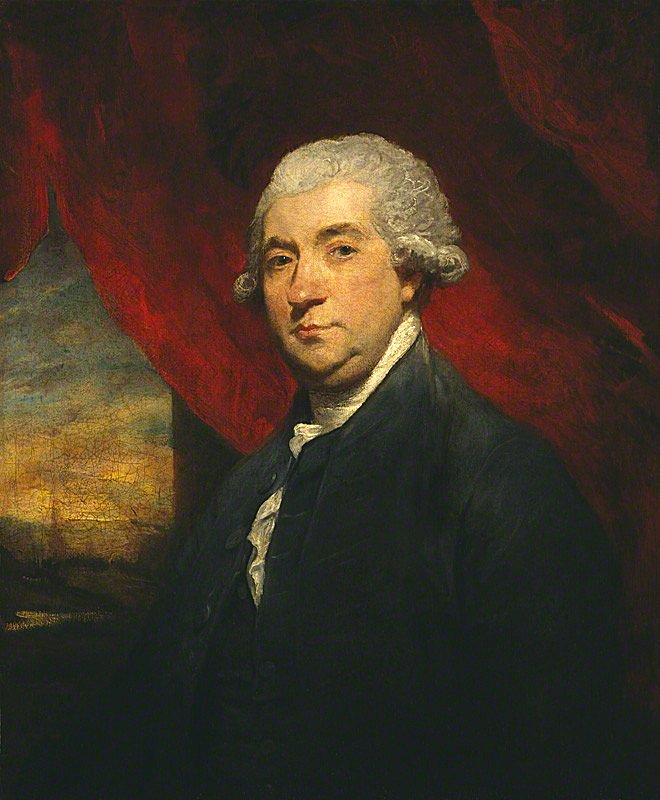
James Bowsell painted by Sir Joshua Reynolds in 1785; Creative Commons Licence
1780 … Wednesday 19 April. Finished my law paper quite to my satisfaction. Dined with Commissioner Cochrane at Commissioner Lockhart’s, a hearty good dinner. No other company there but a Miss Christie and Mr Ross, Secretary of the Post Office. I drank porter and port and Madeira and a bottle of Claret, and wished for more. I stayed tea. After which, having still a desire for more social drinking, I …
Boswell proceeded to get properly drunk and ended up that night following street prostitues, for which he was as usual greatly contrite in the days that followed. But what an excellent scene, with the virtuous Henrietta Gordon and her husband Thomas Lockhart entertaining the brilliant but louche lawyer and biographer.
The company at that meal contained another person of great interest, Mr. Ross, Secretary of the Post Office. David Ross was an old friend of the Gordon family. His father had been gardener to Sir John Gordon of Invergordon, Henrietta’s uncle, and I believe that it was through Sir John that David had obtained his first post, as Accomptant at the Customs Office. He acted as the Edinburgh ‘doer’ for the Gordons, was exceptionally capable and went out of his way to look after family and friends. For much more on David Ross, see my story in an old edition of the Highland Family History Society Journal: ‘“Honest David” – David Ross of the General Post-Office in Edinburgh’
This, then, was the kind of social life that could not be obtained by David Urquhart at home at Braelangwell.
In my complementary story on the children of Henrietta Gordon and David Urquhart I have shown how Henrietta courted that political powerhouse, her cousin The Honourable Henry Dundas, with a view to placing her children in secure positions with good prospects. David continued the supplications after her death, which occured on 17 April 1799.
Marriage to Margaret Hunter (1767–1839)
Five years after the death of his wife Henrietta Gordon, David Urquhart of Braelangwell was to marry again, to Margaret Hunter (1767–1839), the daughter of an Edinburgh merchant. Margaret was no stranger to the family. I see that as far back as 1799, when Margaret would have been 32, she was at home with them. The source for this is the Caledonian Mercury of 21 November 1799, which set out on that date all the National Defence subscriptions for the parish of Kirkmichael and Cullicudden (most of the parish contributed). The first set of entries comprise the household of Mrs Urquhart, of Newhall, and it is fascinating to see several of the characters found within this story contributing. The very first entry is “Miss Margaret Hunter L.2.2.0”. Now, I think that the list of subscriptions had been compiled long before publication date as Henrietta herself features on it, donating 10 guineas (“Mrs Urquhart, of Newhall 10.10.0”). The paper had been working its way intermittently across the parishes of Scotland setting out the tens of thousands of people who had donated to the National Defence months before. I wonder what the role of Margaret Hunter was in the household at this time – perhaps even as companion to Henrietta?
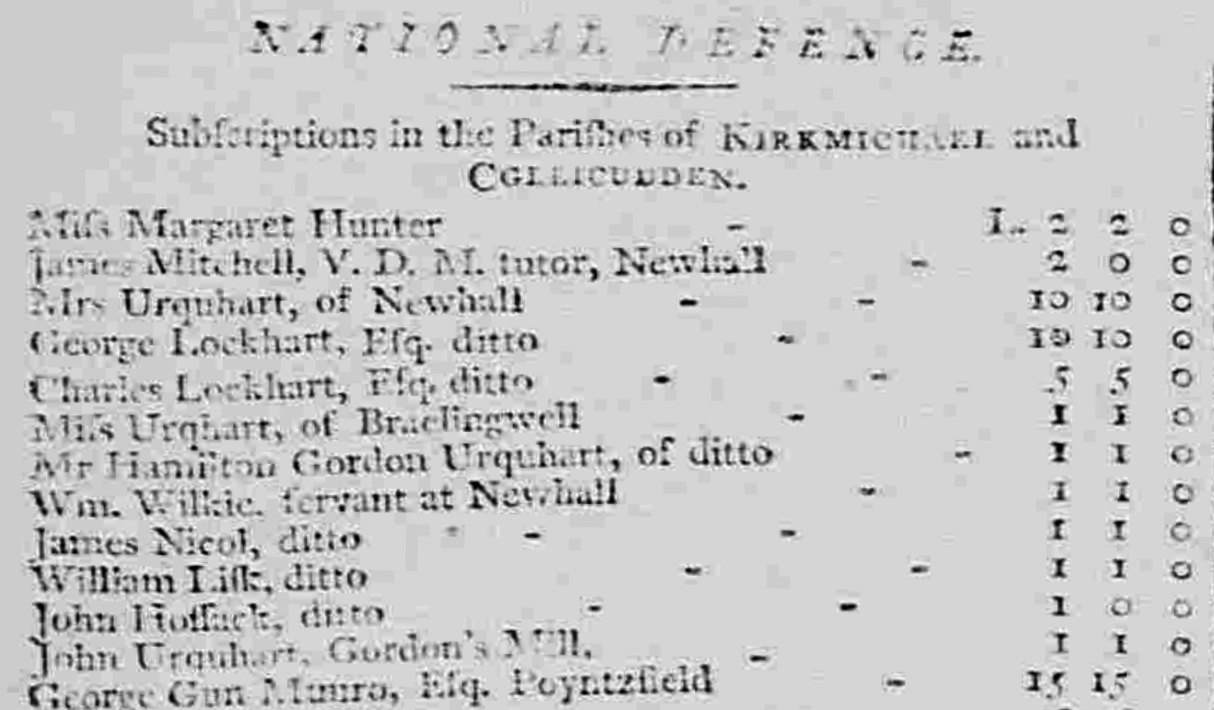
Caledonian Mercury 21 November 1799
David and Margaret were to marry five years later, in Edinburgh.
Edinburgh Marriages
1804 … June … 25th … David Urquhart Esqr: of Braelangwell St Andrew Church Parish and Miss Margaret Hunter New North Church Parish Daugr: of Mr Jas. Hunter Mercht. of Edin.
Two more children were to follow, a son, the renowned David Urquhart (1805–1877), one of whose more unusual claims to fame was popularising the Turkish Bath in Britain, and a daughter, Agnes (1807–1810), who sadly died an infant, but whose name lives on in the small settlement initiated by her father, Agneshill in the Black Isle.
Margaret Hunter does not feature as much as she should in the story of her son, the renowned diplomat, David Urquhart. It was she who was responsible for his education, his early travel, the influences to which he was exposed. Even her birthdate is usually given wrongly as 1769 when in fact she was born on 11 June 1767:
Edinburgh Baptisms
1767 … Sabbath 14th June
James Hunter Mercht. in New North Kirk parish and Ann Begbie his spouse, a Daugh. named Margaret, witnesses Chas. Hunter Bookbinder in Edr. & Peter Begbie Ingraver there. The child was born 11th Inst..
James Hunter wrote his will in 1803. He owned shops, warehouses and houses in Edinburgh. I do not want to make it sound cold-blooded, but he wrote his will in 1803, David Urquhart married Margaret in 1804, and James Hunter died in 1805. It was convenient that Margaret could thus access her share of the estate immediately. I note he left Margaret a small, personal gift as he recognised her work in helping to look after her brothers and sisters.
At the baptisms of his children, his wife is given as Ann Begbie, but in fact in his will he calls her Agnes or Agnus Begbie, so it is clear where the name of Agnes, the first and only daughter of David Urquhart and Margaret Hunter, came from and, in turn, where the name of Agneshill came from.
In Gertrude Robinson’s David Urquhart Some Chapters in the Life of a Victorian Knight-Errant of Justice and Liberty (1920), apart from mentioning that his mother was young David’s constant companion, and that she had individual ideas about education, there is very little about her life or nature. She is said to have been of an evangelical nature. There is a brief mention that Sir Herbert Taylor, the private secretary of William IV, was a lifelong friend of David’s mother. How had they met? Did they exchange letters? It is a little tantalising. This is about all you will glean:
Urquhart’s education was conducted by his mother in an altogether original manner. He was delicate as a child, and at ten years old she took him abroad with a tutor. They lived in France, Switzerland, and Italy, and Urquhart’s studies were superintended by first one tutor, then another, more or less unsatisfactorily. …At Soreze Urquhart’s education began in earnest. He was at school as an extern from 5.30 a.m. until 7 at night, and often sat up till midnight preparing his lessons for the next day. He had a tutor to help him with Latin and Greek, but Mrs. Urquhart describes him as a “heavy burden.” “His master,” she says in a letter to David’s half-sister, Henrietta, “does not even raise him. I have had him so often vexed that I have a woman to come on purpose to wake him. We keep the fire in, and sometimes his anxiety is snch that he gets up at 3 o’clock and studies.” No wonder an old friend writes to Mrs. Urquhart: “I cannot think that it is good for our darling David to study such long hours.”
Brought up by a clever and original mother, whose piety took the form of extreme Evangelicalism, his education threw him during the most impressionable time of his young life into contact with Catholics in foreign schools. … In order to break the Malan influence Mrs. Urquhart sent David to travel in Spain for six months with a tutor. When the lad was close upon sixteen mother and son returned to England. Coming back to his native land must have been a new experience for young David, who had been abroad since his eleventh year.
…
Urquhart had been his mother’s constant companion from infancy. Left a widow while he was still a young child, all her devotion was centred upon him. Her great desire was that he should gain a knowledge of men and things before “he went into abstruse studies,” which she had observed “hardened the feelings and destroyed the heart.”
Margaret’s death was reported in all the papers of the time, as by now the diplomat David Urquhart was a household name. This is from the London Sun of 22 January 1839:
On the 18th inst., in Grafton-street, Mrs. Margaret Urquhart, widow of the late David Urquhart, Esq., of Braelangwell, North Britain.
No. 8 Grafton Street, London, was the residence of the diplomat David Urquhart in the late 1830s. Nowadays Grafton Street is the most expensive street in London.
George Hunter (1770–), Sir Walter Scott and King George IV
I am most grateful to Virginia, Dowager Urquhart of Urquhart, who drew my attention to George Hunter (brother of Margaret Hunter, spouse of David Urquhart) and the outfitting of King George IV in 1822 for his Royal Visit to Scotland, which firmly endorsed the modern fashion of Scots dress.
George was Margaret Hunter’s eldest brother, born in 1770, and at time of their father merchant James Hunter&rsqyils death in 1805 George (according to his father’s will) was in possession of his father’s shop and warehouse at 96 South Bridge Street Edinburgh. He was clearly well-established as a merchant in his own right by this time.
In 1807, I see “George Hunter, Clothier and Mercer to his Majesty” (by which I understand he was authorised to sell kit to the military forces) advertising the premises at 96 South Bridge Street saying he was about to retire from the business. But in fact he seems to have been unable to get the price he wanted as George Hunter & Co. was still at No. 96 in 1812 (advertisement in the London Courier and Evening Gazette of 12 March 1812).
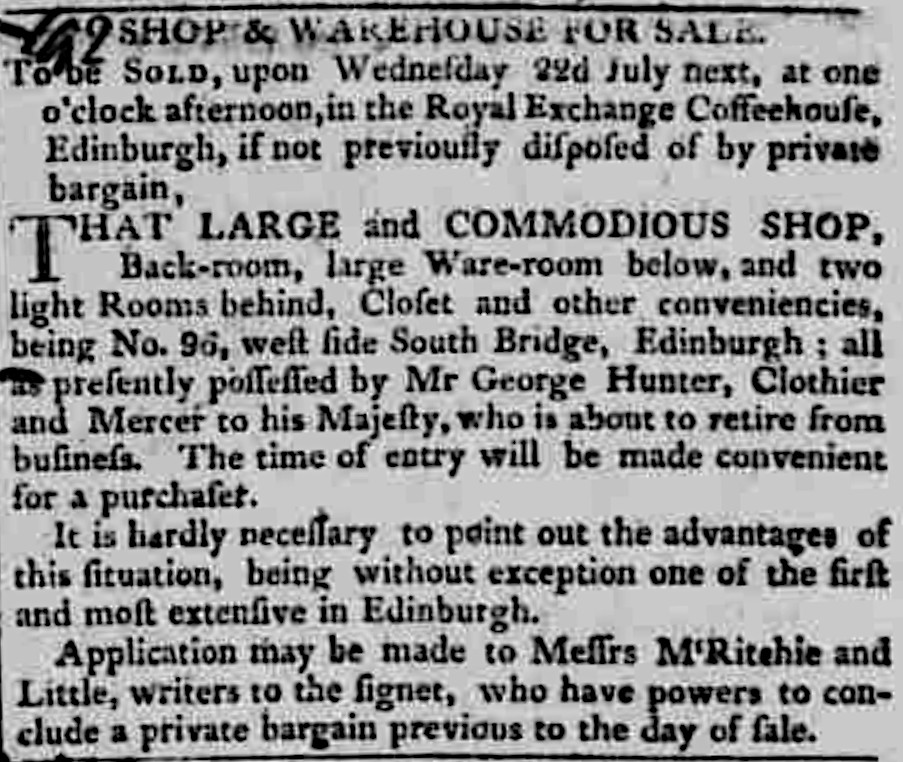
Caledonian Mercury 11 June 1807
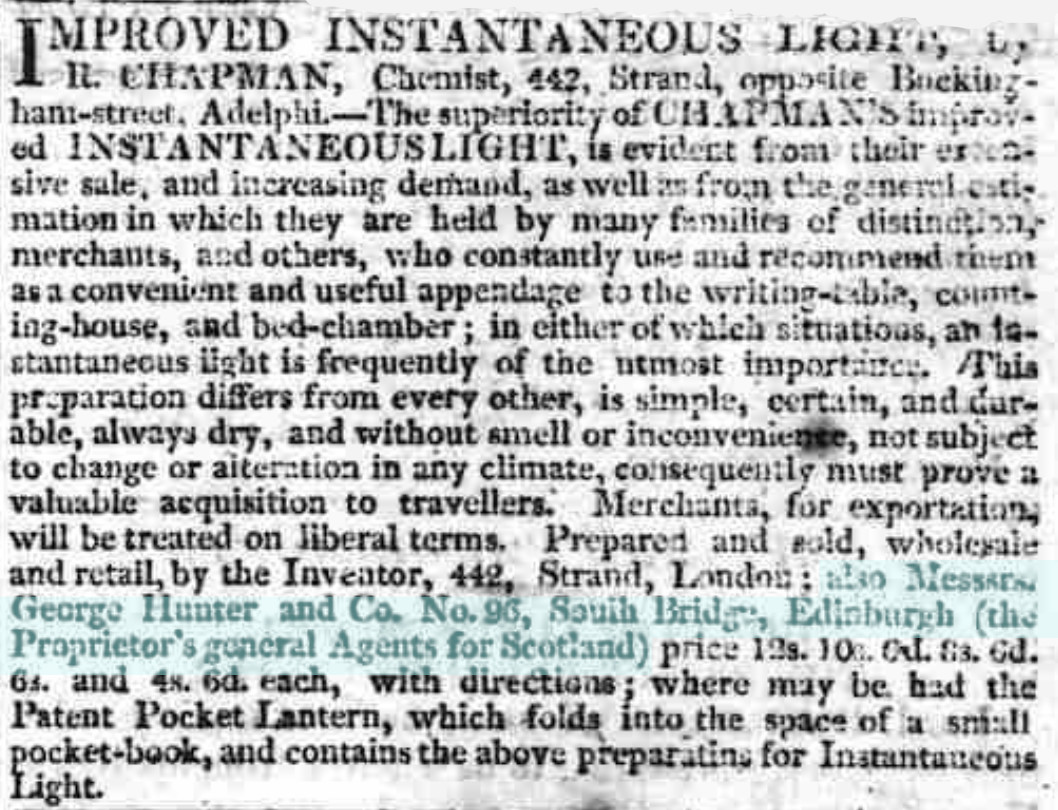
London Courier and Evening Gazette 12 March 1812
Within the next few years he transferred to Princes Street. This was at least by 1818, as I see:
Caledonian Mercury 8 August 1818
Thursday the store-room adjoining the shop of Messrs Hunter and Co. clothiers and army furnishers, Prince’s Street, was discovered to be on fire; which, by the prompt assistance usually afforded on such occasions, was soon got under without doing much damage.
At this time I don’t see much in the way of advertisement – presumably the firm prospered quite happily without newspaper advertising. The only snippets come from news items such as this:
Caledonian Mercury 6 December 1819
HIGH COURT OF JUSTICIARY. This morning the Court proceeded to the trial of James Wallis, accused of breaking into the shop of George Hunter and Company, Prince’s-street, Edinburgh …
George as a successful merchant must have bought some property and taken on the title of “of D… kay”. This appears from one source. In 1811, when acting as one of the executors to the will of David Urquhart of Braelangwell, he is termed “George Hunter Esqr of ”D…kay Merchant” but I simply cannot be sure of the name of the place mentioned. There are two examples given, and I could research it more thoroughly if it could be made out. I provide the two samples and if you can assist then please let me know!


George Hunter achieved some fame as the recipient in 1822 of a high value, prestigous supply order from no less than King George IV.
George at the time of this Royal commission was still an army contractor, military outfitter and supplier based at 25 Princes Street, Edinburgh, and Tokenhouse Yard, London (this last I take on trust, as I have not seen an original source referring to his London warehouse). The wildly popular romantic novels from Sir Walter Scott in the years preceding this had engendered enormous interest in Scottish dress. Scott was drawn in to the planning of the Royal visit to advise on the pageantry. And George Hunter was commissioned to supply the full Highland Dress, including the new Royal Stewart tartan, and weapons. This would complement other Clan tartans on parade, many invented by weavers William Wilson & Son and George Hunter especially for the occasion.
Hunter was quick to announce his commission in the press, and the initial announcement was repeated by all the newspapers in the country. This included the colonial press, but many months later (for example, the Bombay Gazette of 8 January 1823)!
The announcement was that George Hunter had been commissioned to make a “superb and splendid dress of the Highland garb of the royal tartan for his Majesty. This gentleman has furnished similar dresses to the Emperor of Russia, Dukes Constantine, Nicholas, and Michael, and Princes of Orange and Esterhazy.” The dress had to be ready for the King’ visit to Scotland in August 1822. George IV was the first reigning monarch to visit Scotland since Charles II so it was of enormous popular interest. The royal visit proved to be a great success, and started the Scottish love affair that would be further developed by Queen Victoria and Prince Albert in their turn.
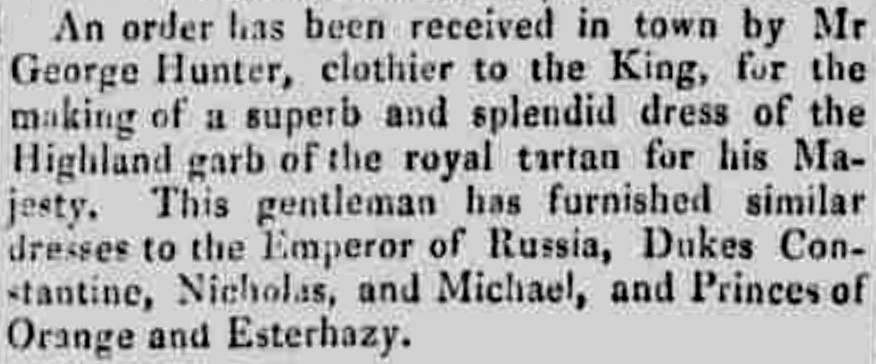
Caledonian Mercury 22 July 1822
George Hunter provided the dress, including sword, dirk and pistols for – michty! – £1,354.18s! And between George Hunter and Sir Walter Scott the tartan perception of Scotland was permanently popularised.
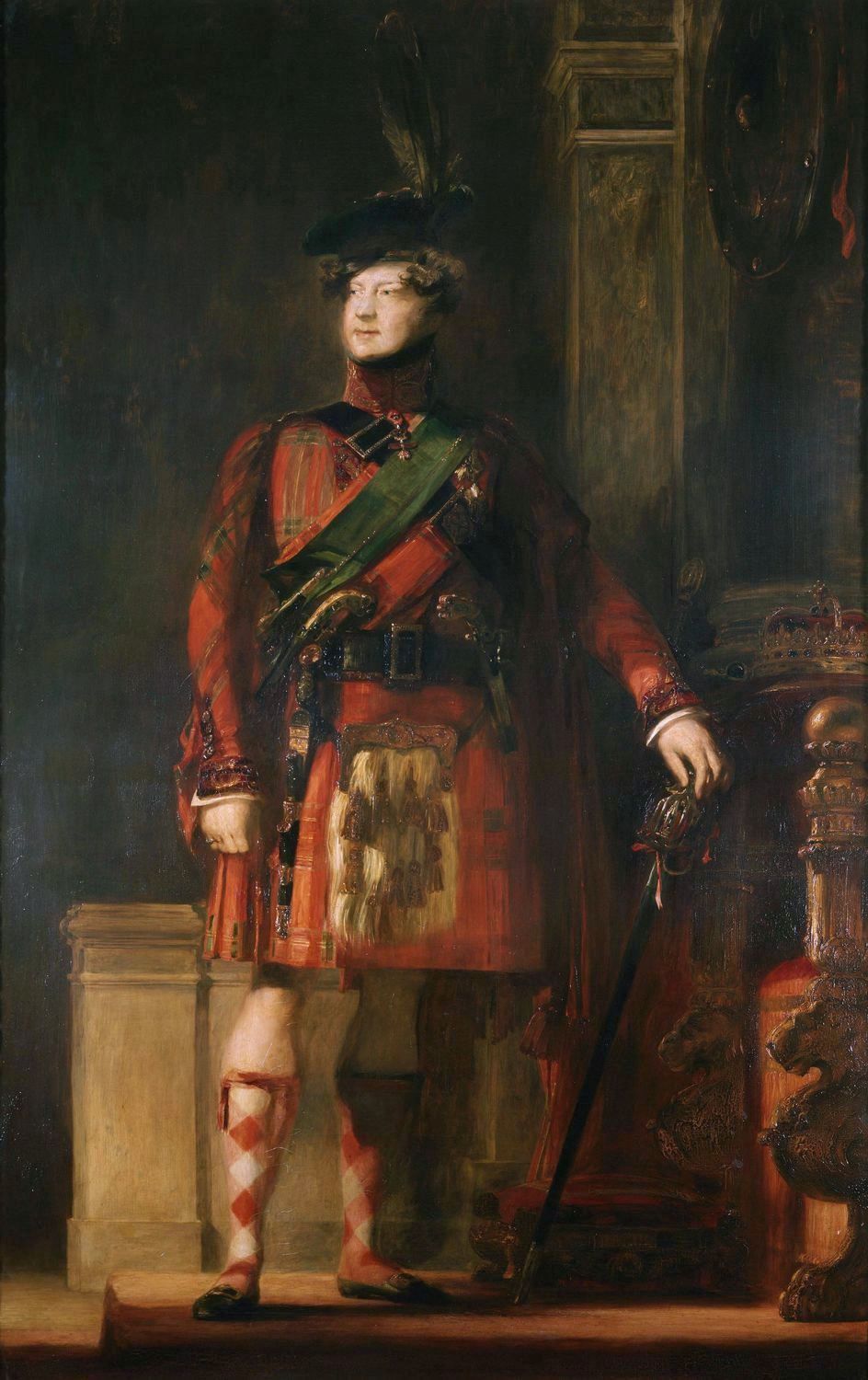
King George IV in the outfit supplied by George Hunter; painting commissioned by George IV and executed by David Wilkie in 1829; Public domain, via Wikimedia Commons
Nobody seems to know what happened to George Hunter thereafter. I see one last advertisement in August 1822 and then he disappears from view. He had said decades earlier that he intended to retire; presumably this was a suitably crowning moment to do so.
David Urquhart and Politics
A confidential Whig report of 1788 into political affiliations prior to the 1790 election finally saw publication a century after it was originally compiled (View of the Political State of Scotland in the Last Century: A Confidential Report on the Political Opinions, Family Connections, Or Personal Circumstances of the 2662 County Voters in 1788 by Sir Charles Elphinstone Adam (1887)). It contained the following entry for the Shire of Cromarty:
David Urquhart of Braelangwell.
In right of his wife, Henrietta Gordon of Newhall. Made a fortune in India. Married the cousin of Mr Dundas, the widow of Commissioner Lockhart. It is thought will go with Brodie.
The confidential Whig report was correct in that David Urquhart did indeed side with the Henry Dundas-backed Alexander Brodie in the subsequent election in 1790. Many of the dubious voters had been stripped out of the electoral roll in the years following the Pulteney flagrant abuses, so in fact there were only a few voters in that election. Brodie lost to Duncan Davidson 4 to 3, but regarded it as a success as he had another secure seat and he had gained commitments that would guarantee a successful Henry Dundas candidate for the Shire of Cromarty at the next election (although in fact Henry Dundas changed his own position in the intervening period). For the full story, see the excellent https://www.historyofparliamentonline.org/volume/1790-1820/constituencies/cromartyshire .
The most interesting note in that confidential report is: “Made a fortune in India.” I have to say I have little information on David Urquhart’s time in India, but the fortune he is reputed to have made could not have been that substantial as he seems to have been bedevilled by debt. Of course, he did spend a considerable amount in improvements of the Estate. And talking of which…
David Urquhart, the improver
David Urquhart was one of the most forward-thinking agricultural improvers in the north. I note in 1798 he was a judge for the Highland Society of Scotland for “ Encouraging Improvements in Agriculture, and Mending the Breed of Black Cattle in the year 1798.” He himself spent much money in innovatory farming practices and modern agricultural buildings.
In the First Statistical Account, the Resolis section of which was written in 1792, the Reverend Robert Arthur writes:
Rich shell-marl was discovered, a few years ago, in a small loch near the mansion-house of Braelangwell, which the proprietor has used, as a manure to his fields, with great success. … The late Sir George Munro was the first, in this part of the country, who began improvements in agriculture on a large scale, by enclosing, planting, draining, liming, fallowing, and sowing green crops on his mains of Poyntzfield, which now add greatly to the beauty and value of that part of the estate; and very great improvements have been carried on in all these respects, on the mainses of Braelangwell and Newhall; and these 3 contiguous seats, in full view of the noble bay and harbour of Cromarty, form as beautiful a landscape as can be imagined. … The increase of population from 1789 to 1792, was owing to the great encouragement given by Mr. and Mrs. Urquhart of Braelangwell and Newhall to people who settled on, and improved moor-ground. … There is no natural wood in this parish, with the exception of a few patches of birch, quaking-ash, and hazel, growing on the banks of the rivulets, running through the estates of Poyntzfield and Braelangwell. The surface of the parish where it has not been planted is generally bare and moorish, yielding only furze, and a stunted kind of heather. Very extensive plantations of Scotch fir have been cut down on the estates of Newhall and Braelangwell. The larch fir in small patches, or mixed with the Scotch pine, has been lately introduced by such of the proprietors as have considerably improved their estates.
And that indefatigable compiler of lists, who was in fact responsible for the Statistical Account, Sir John Sinclair of Ulbster, noted in his General view of the agriculture of the northern counties and islands of Scotland; including the counties of Cromarty, Ross, Sutherland, and Caithness, and the islands of Orkney and Shetland. With observations on the means of their improvement. Drawn up for the consideration of the Board of Agriculture and Internal Improvement. (1795) (a title much longer than the extract):
Woods and Plantations.–
Mr. Urquhart, upon his estate of Braelangwell, has a very thriving plantation of young oaks, some from the seed, and some planted.
David Urquhart was allowed the opportunity to list some of his improvements himself in the more snappily-entitled A General Survey of the Counties of Ross and Cromarty, drawn up for the consideration of the Board of Agriculture by Sir George Stewart Mackenzie, Bart. [of Coull] (1810).
Braelangwell is a small, but very comfortable modern house. The exertions of the proprietor, David Urquhart, Esq. in improving his property, are well known, and have long been admired. … Some Particulars respecting the Old Shire of Cromarty, from a Communication made by David Urquhart, Esquire, of Braelangwell.
The old shire of Cromarty, or, as it is called by the inhabitants, the sheriffdom, consists of the parish of Cromarty, and three-fourths of the parishes of Kirkmichael and Cullicudden, united under the name of Resolis. But for political purposes, all the property belonging to the Earl of Cromarty, which was locally situated in Ross-shire, was annexed to the county of Cromarty.
There was no Gaelic spoken in Cromarty till about thirty years ago, when a hemp manufactory was established, which brought so many people from the Highlands, as to render a place of worship, in which the service would be performed in their own language, necessary. A chapel was built accordingly, and a clergyman settled, with a stipend of L.50 per annum, paid out of the bishop rents; it has lately been augmented to L.100 Sterling.
From there being no Gaelic spoken in the parishes of Cromarty, Rosemarkie, and Avoch, which stretch along the coast of the Murray Frith towards Inverness; from a number of customs peculiar to the inhabitants, and the singularity of their names, there is every reason to believe, that this district was settled by the Saxons, and that the present people are their direct descendants.
Dalrymple states in his Annals, that when Edward the First appointed sheriffs in Scotland, the only offices which were then hereditary, were the sheriffdoms held by the Urquharts of Cromarty, and the M’Cullochs of Wigton.
In the old shire, there may be about 4500 acres of arable land, about 4000 of waste land, and about 2000 under natural wood, and planted. There is a claim of commonty on the Millbuy, or Ardmenach. Cromarty and Nairnshires are alternately represented in Parliament.
There are four properties held of the Crown, and two small estates held of subjects. There are only eight farms, the rent of which exceeds L.100 per annum, with the old practice of in and out field. A few tenants have leases, and they pay from 10s. to 30s. per acre. The land near Cromarty fetches L.2, 10s. per acre. The large farms only are inclosed. The proprietors in general are active in improving waste lands, inclosing their farms, and making considerable plantations.
With a view to promote industry, and give employment to the poor, a proprietor* [footnote: *David Urquhart, Esq., a gentleman, whose patriotic spirit and sound judgment, have enabled him to set a most important example.], some years ago, established a mill for carding wool, and jennies for spinning it, also a wauk-mill, two flax-mills, and a flour-mill. After encountering all the difficulties by which new plans are always attended, he has now the satisfaction of seeing them answer the purposes for which he intended them. Mr Urquhart has planted an orchard of thirteen acres, which is the only one of consequence in the north.
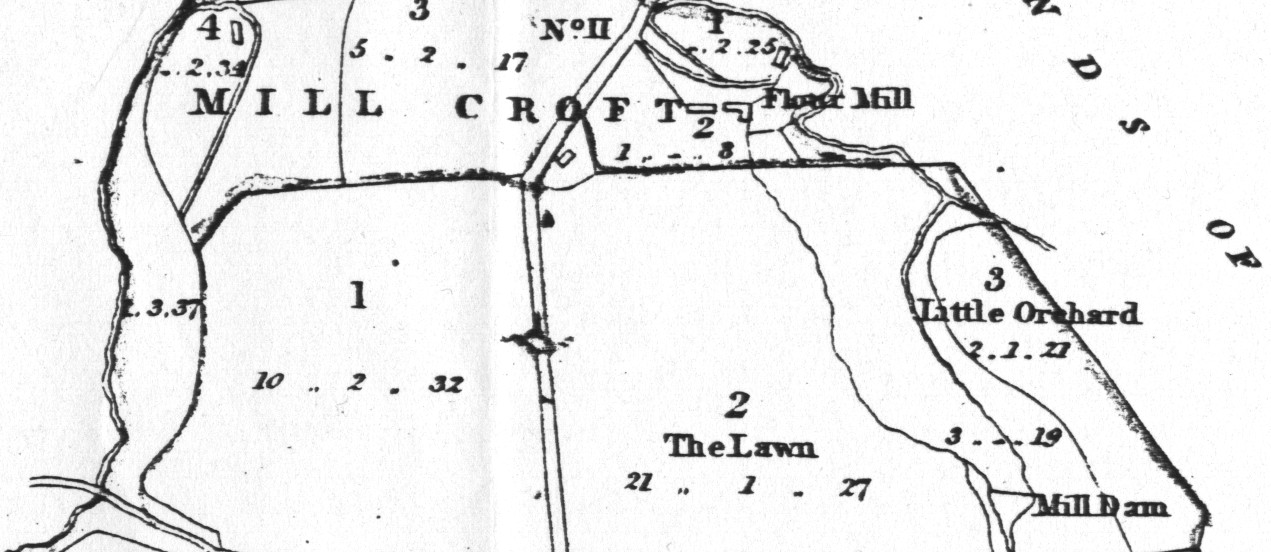
Putting to one side his dubious suggestion that there had been no Gaelic spoken in the seaboard villages of the Black Isle until about 1780, and his even more dubious conclusion that the people of Cromarty, Rosemarkie and Avoch were therefore of Saxon origin, it is David Urquhart’s notes on his own work that stand out. I think in describing his mills he included the mills which his wife Henrietta was responsible for at Gordon’s Mill with his own mills at Braelangwell. The flour mill at Braelangwell was famous, as flour of course comes from wheat, and in those days there were few arable acres in the North of Scotland on which wheat could be successfully grown and harvested. The mills were a selling point:
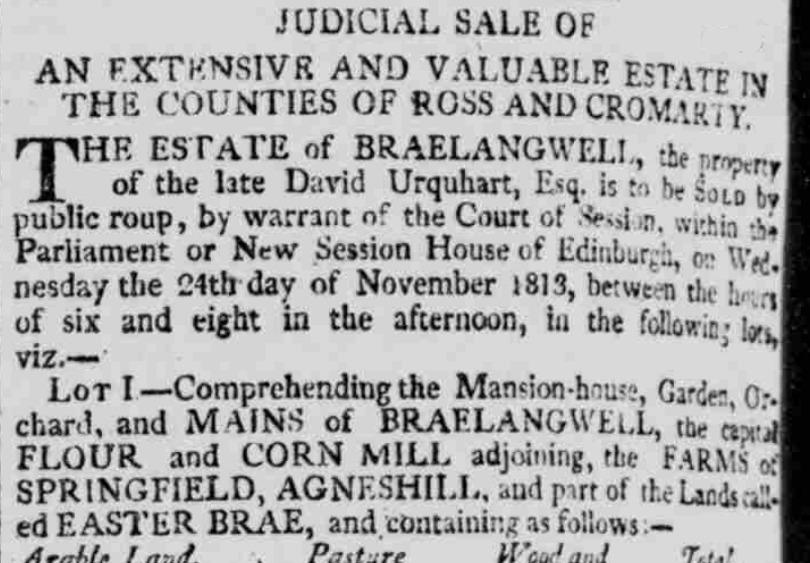
Caledonian Mercury 23 October 1813
In the role of improving proprietor, David Urquhart was very active on the Commissioners of Supply, not so much on the electioneering front as his father, but more for improvements to the infrastructure of the area. Thus he took on himself the responsibility of overseeing the road works carried out by tenants under statute in the area (and very unpopular this work was too).
His Last Days
David Urquhart had an eventful, well-travelled life; childhood in the Black Isle, University education in Aberdeen and Edinburgh, career as Surgeon Major in Bengal, and then the dual role as landed proprietor at Braelangwell and cultured gentleman in Edinburgh. In his later years, he planned to provide for his immediate family and to ensure that Braelangwell would continue in the family under the care of his eldest surviving son, Charles Gordon Urquhart. He therefore prepared a legal device in 1809, whereby the core old estate of Braelangwell as well as St Martin’s would descend to Charles Gordon Urquhart, or other heirs in tailzie, whilst everything else in his ownership including the lands of Drumcudden and all his plantations of trees would go to pay off his debts and provide annuities for his named relatives.
It was a lovely vision, but it was not to be. David died in 1811, and the executors of his will began to carry his wishes into effect. An inventory of his possessions, including debts owing to him, both recoverable and “desperate”, was drawn up. Those irrecoverable debts included an eye-watering 1,336 pounds sterling owed to him by the dissolute Lieutenant Colonel Lewis Mackenzie of Scatwell, deceased husband of one of the daughters of Henrietta’s marriage with Commissioner Thomas Lockhart. They also included a debt to a certain Captain David Urquhart of the 72nd Regiment who I suspect may have been a son of Newhall factor Kenneth Urquhart who had become a land-surveyor and had actually been a tenant before joining the Fraser Fencibles. However, that is an investigation and story for another time. I think the Executors would have been shocked as the claimants on the Estate appeared out of the woodwork. David Urquhart had secured many loans and it would be interesting to research who all his creditors were. I am aware, for example, from the will of the Reverend Thomas Urquhart of Rosskeen, who died in 1815, that an unrepaid loan to David amounted to £190, and there were many more. When John and David Holm became executors dative qua nearest in kin in 1816 to Anne Matheson, the sole property of Anne was a Promissory Note for sixteen pounds sterling granted in 1808 by David Urquhart of Braelangwell, plus a lot of interest. Big and small, the creditors descended on the estate.
It was therefore no surprise that Charles Gordon Urquhart sold Braelangwell to address these debts. It was then that a truly shocking liability emerged to face the tutors of the daughters of Charles Lockhart of Newhall, of whom Charles Gordon Urquhart was one. The details are set out in my complementary story about the children of Henrietta Gordon and David Urquhart. The tutors had in 1810 lent £3,000, belonging to the pupils, to David, for which he granted an heritable bond over the estate of Braelangwell, by which he bound himself to pay that sum to the pupils. Through it would appear no intention of the tutors the money was lost and they became liable to the children. At the end of the day, there must have been enough money to secure the annuities to the relatives identified in David’s will: Mrs Margaret Hunter, his wife; Henrietta, his daughter; Sophia, his natural daughter; Mary Munro, his niece; Elizabeth and Jean, his sisters. Charles Gordon Urquhart (who would die in Gramvousa when he had just been made Governor) and David Urquhart (the future diplomat and M.P.) were to inherit under the entail.
David Urquhart’s dream of Braelangwell continuing in his family was therefore not realised. However, the heritage of the family includes the beautiful mansion house of Braelangwell. And, on a different scale, the chancel at Kirkmichael is a tribute to the good taste and culture of the Urquharts of Braelangwell.
The Origins of Agneshill
The great commonty of Mulbuie was a valuable resource to the ordinary people of the Black Isle. It was a source of fuel, thatch and summer grazine. The inhabitants on each estate around the Black Isle had roughly their own patch for their use, and the pattern of usage was examined closely in the legal proceedings of 1816 as part of the long-drawn-out process of breaking up the commonty and distributing to each of the estates around its periphery. The ordinary people giving evidence at that legal proceeding would soon lose the benefit of the commonty .
But even before the legal division of the Mulbuie Commonty various estates were staking their claim to the undefined moorland above their tenanted land. I’m sure that this was the intention behind “Colony” established by the Cromarty Estate high in the moors above itself and the Estate of Poyntzfield. The land might not be as productive as the farms lower down but crops could still be grown and animals raised on the higher ground. Forests could be established to yield timber, easily carted to shipping points on the Firths. The Mulbuie was ripe for exploitation.
David Urquhart of Braelangwell and his wife Henrietta Gordon of Newhall were noted to be settling tenants to take in moorland. Thus we hear from the Reverend Robert Arthur in the First Statistical Account (written in 1792) that:
The increase of population from 1789 to 1792, was owing to the great encouragement given by Mr. and Mrs. Urquhart of Braelangwell and Newhall to people who settled on, and improved moor-ground.
We do not hear exactly where David Urquhart was settling these people, but it becomes clear in a complaint lodged by the Reverend Arthur to the Presbytery in 1810. I have emboldened the specific section of the complaint, but in fact the whole complaint is of particular interest. For instance, the original route from Alness Ferry to Fortrose must have been much more direct once upon a time, presumably running up the steep brae to Agneshill and just to the west of Wood of Brae before joining up with the route of the current road to Fortrose.
That tho’ your petitioner has but little personal Interest, comparatively speaking, in the Cause which he now begs leave to submit to the Consideration of his Presbytery; he cannot pass unnoticed the great Encroachment made on the Interest & Convenience – of his parishioners,– the public at large,– and the Rights & Interests of the Ministers of Kirkmichael & Cullicudden in all time coming,– without stating them to the Reverend Court.
1mo. David Urquhart Esqr. of Brealangwell, one of his principal Heritors, having first settled a Number of Mealers or Cotters on the nearest and best part of the Common called the Mulbuy, on the South-Side of the Burn called Aultdouack, did lately, in Conjunction with Donald Mackenzie Esqr. of Newhall, begin & carry on very extensive plantations of Fir &c. on said Common, to the almost total Exclusion of your petitioner, and the other Inhabitants of the East End of this parish, from the Right of Pasturage as well as of obtaining Fuel: both which, the Ministers & Inhabitants of this parish had enjoyed for Time immemorial.
2do. The said Mr Urquhart has, by his own authority, taken upon himself to shut up two Public Roads, leading through said United Parish,– the one from the Ferry of Alness, to the Royal Burgh & Market-Town of Fortrose, & Ferry of Fort-George; and which, until shut up by Mr. Urquhart, was always the Kirk-Road from the wester end of the Estate of Poyntzfield, & part of the Estate of Brealangwell. The other Road leading from the Manse of Risolis to said Common & Inverness; by which your petitioner & his predecessor, as well as a great number of his parishioners to the North & East of the Manse, were wont to bring their Fuel from the Mulbuy; & which was also a common Road to the Church.
3tio. In consequence of Mr. Urquhart’s shutting up the first-mentioned Road, all Travellers from the Ferry of Alness to Fortrose & the Ferry of Fort-George, have to ride, or walk, a Mile more than formerly: as has your petitioner, when going to the Presbytery Seat.
&nbs; May it, therefore, please the Reverend Presbytery of Chanonry, to grant such effectual advice & assistance in this Case, as they, in their Wisdom, shall see necessary; for securing the Interest of the Ministers of said United parish, as well as protecting its poor Inhabitants from those harsh, illegal, & most unjustifiable Encroachments on his & their just Rights & Priviledges. And your petitioner shall ever pray &c. (Signed) Robt. Arthur, Manse of Risolis, May 1st. 1810.
The said petition being read by the Clerk coram, and the Presbytery having maturely considered the same, they find the Desire thereof just & reasonable, insofar as the Minister of Kirkmichael & Cullicudden’s access to Fuel, his Road also to the Presbytery-Seat, and the Roads formerly used and enjoyed by his parishioners to the Church of said United Parish – are concerned. They therefore did, and hereby do, unanimously Refer the said petition, insofar as concerns keeping patent those local accommodations for Mr Arthur, his Successors in Office, and the parishioners of said United parish of Kirkmichael & Cullicudden,– unto the Venerable Assembly of the Church of Scotland, indicted to meet at Edinburgh the Seventeenth day of May current, for advice & assistance, in any application to the Civil Courts of Scotland, that may become eventually necessary in this affair.
David Urquhart died the following year so the re-routing of roads remained legally unchallenged. David’s son, Charles Gordon Urquhart, finding himself besieged by debts, voluntarily sought sequestration and the estate was judicially sold. Advance notice of the sale was advertised in 1812, and to assist with the process an estate plan was drawn up (“Plan of the Estate of Braelangwall lying in the Parish of Risoles County of Cromarty. Belonging to C.G. Urquhart Esq. Surveyed by Geo. Brown. 1812.&rsdquo;).
I have rotated the estate plan so that it approximately is in line with modern mapping, and blue-dotted the route of the Allt Dubhach. The footpath into the forestry still crosses the burn at the same point as shown on the map. And the plan shows the many holdings established by David Urquhart, shown on the south of this extract. Across the extract can be seen “Agnesshill” – the first reference to the name I have seen.
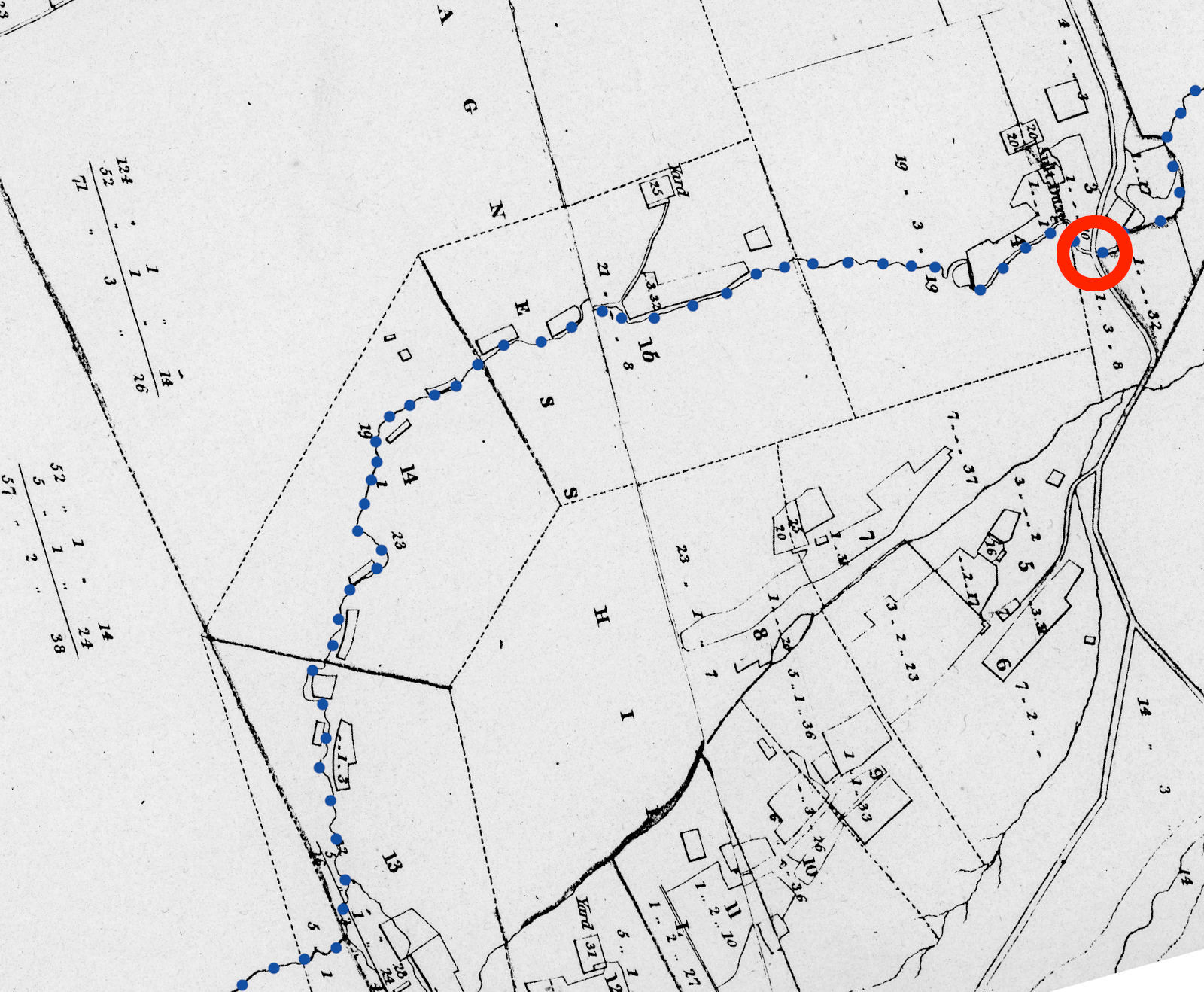
Agneshill (“Agnesshill”) in 1812, with the route of the Allt Dubhach blue-spotted; the red circle encloses the crossing of the Allt Dubhach which is still in use nowadays. The extensive nature of the holdings created to the south of the Allt Dubhach can be seen.
The Allt Dubhach (or Aulduaig and variations) is a relatively small watercourse, although it is fast enough in times of spate. It is hard to believe that it was once a scene of high drama when Braelangwell impounded 50 horses here belonging to the residents of Fortrose who had come this far to gather their moss. But it performed an important locational function and it is often referred to in deeds and cases.
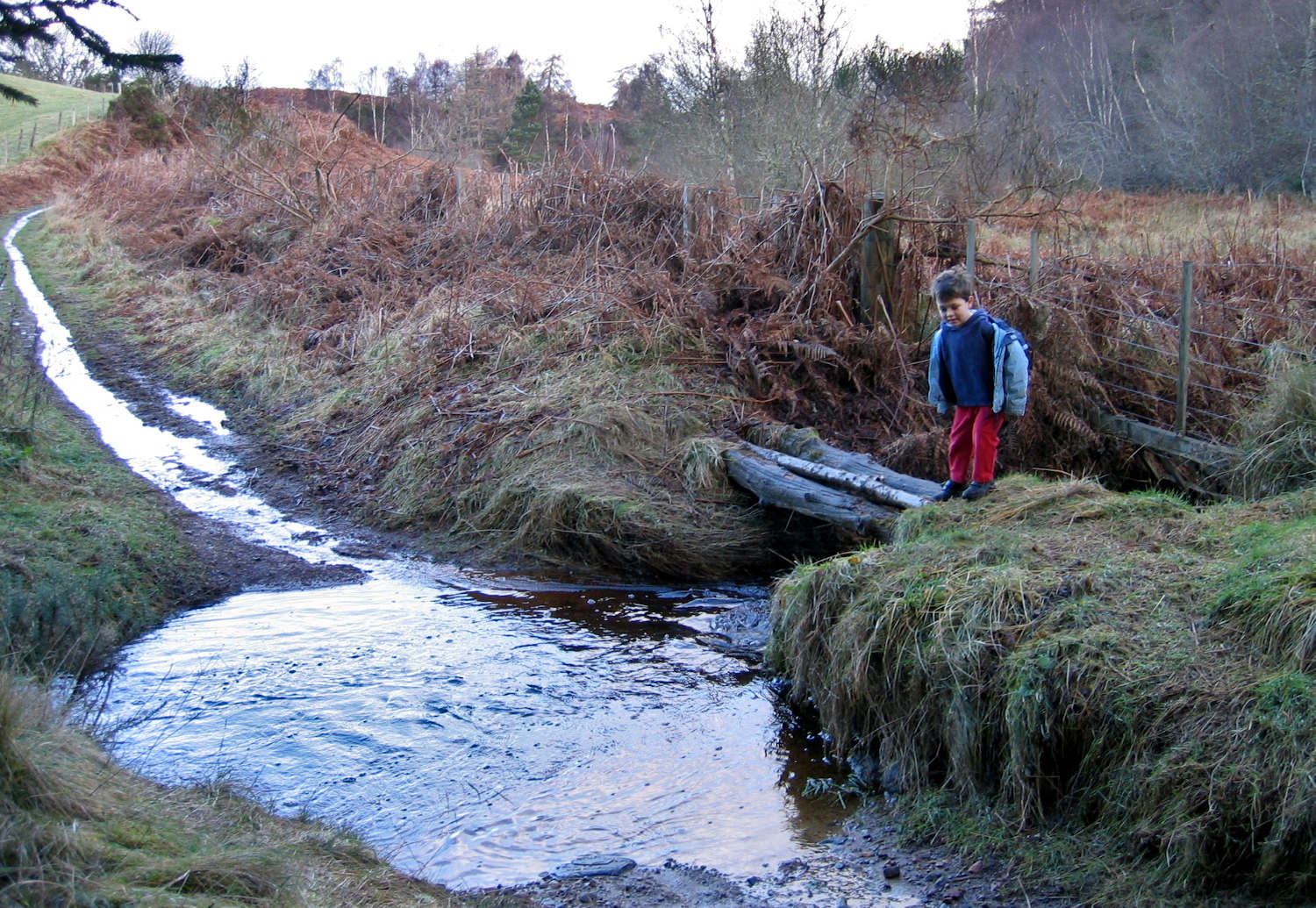
Gavin back in 2004 looking at the Allt Dubhach crossing dubiously; photo by Jim Mackay
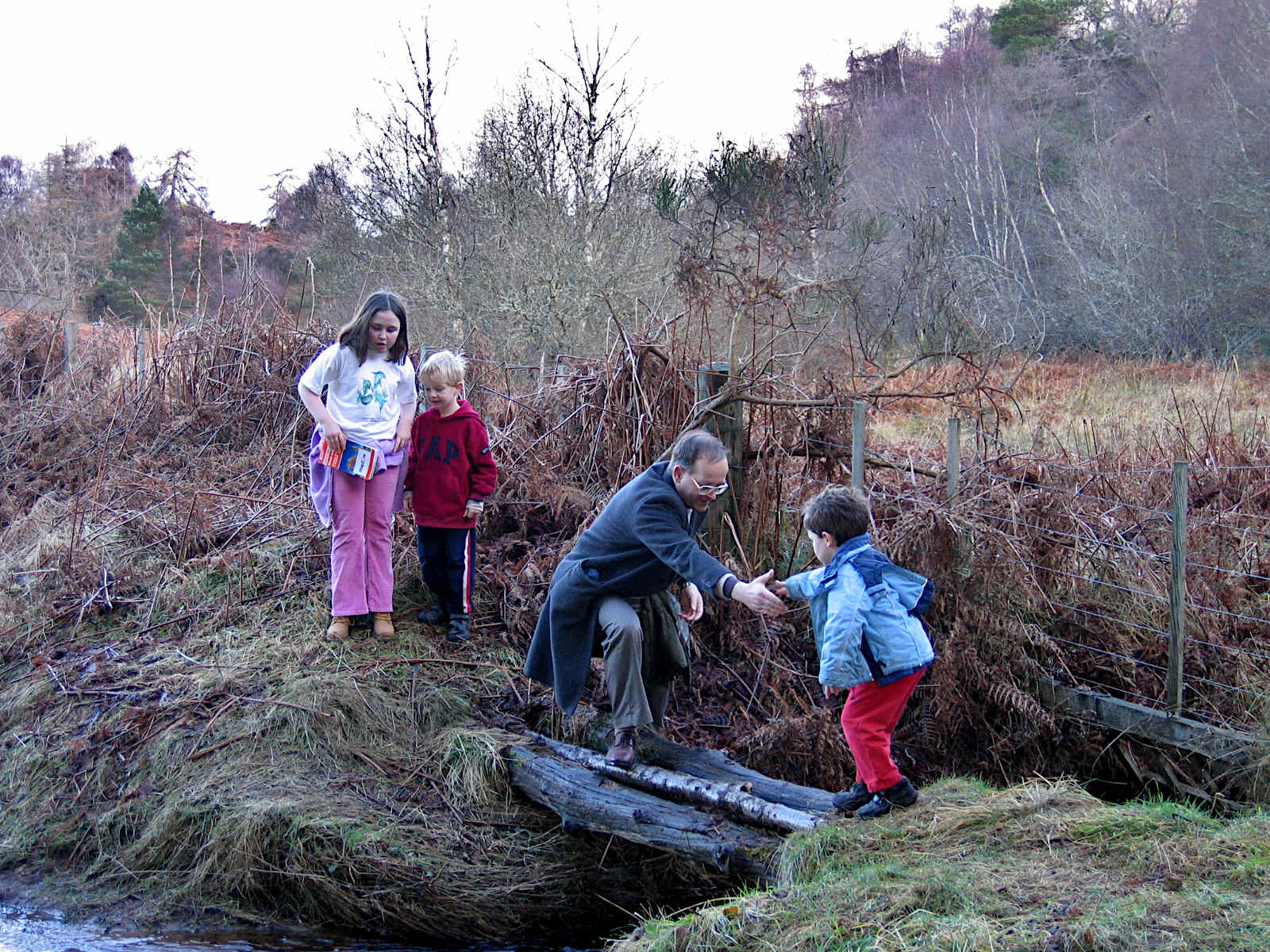
Gavin gets a helping hand from Uncle Ken; photo by Jim Mackay
Whilst Braelangwell’s settlement was on the south side of the Allt Duag, Newhall carried out similar on its land on the north side. The Ordnance Survey one-inch-to-the-mile mapping shows little change from the estate map of 1812:
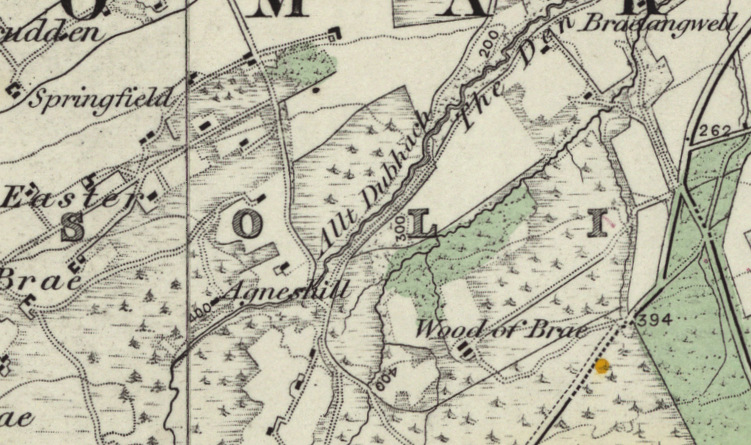
Agneshill on the First Edition Ordnance Survey, published in 1878
The Forestry Commission, hungry for land on which to establish a UK resource of timber after the First World War, came to look at the Black Isle and purchased great swathes of the higher ground, marginal for crofts but excellent, as the estate owners had previously found, for afforestation. The crofthouses of Agneshill were abandoned and their ruins are hidden away in gaps in the forest.
The more northerly area of Agneshill now has a smattering of modern houses, but the original crofthouses of Agneshill are seen only by the keen walker.
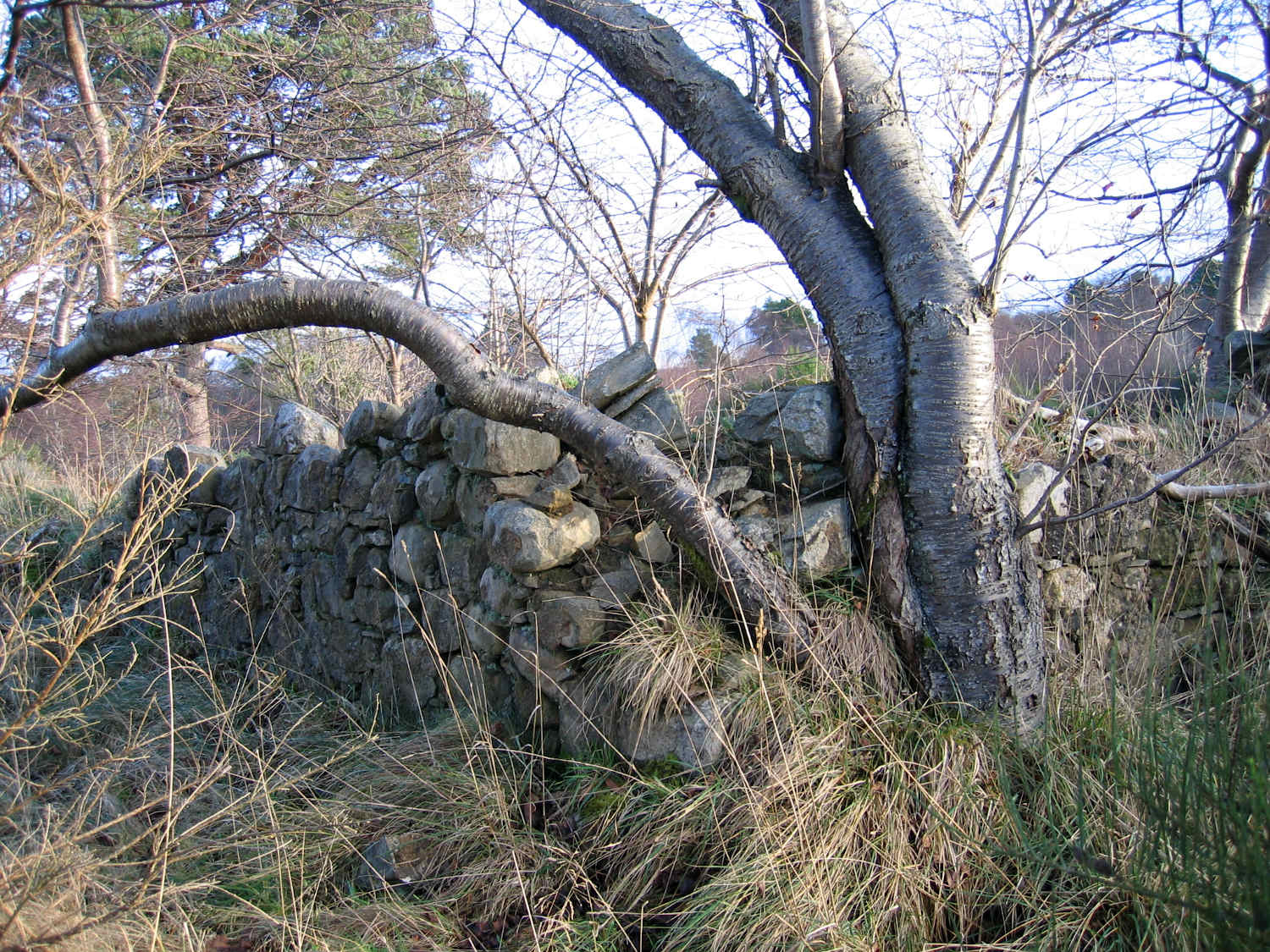
photo by Jim Mackay
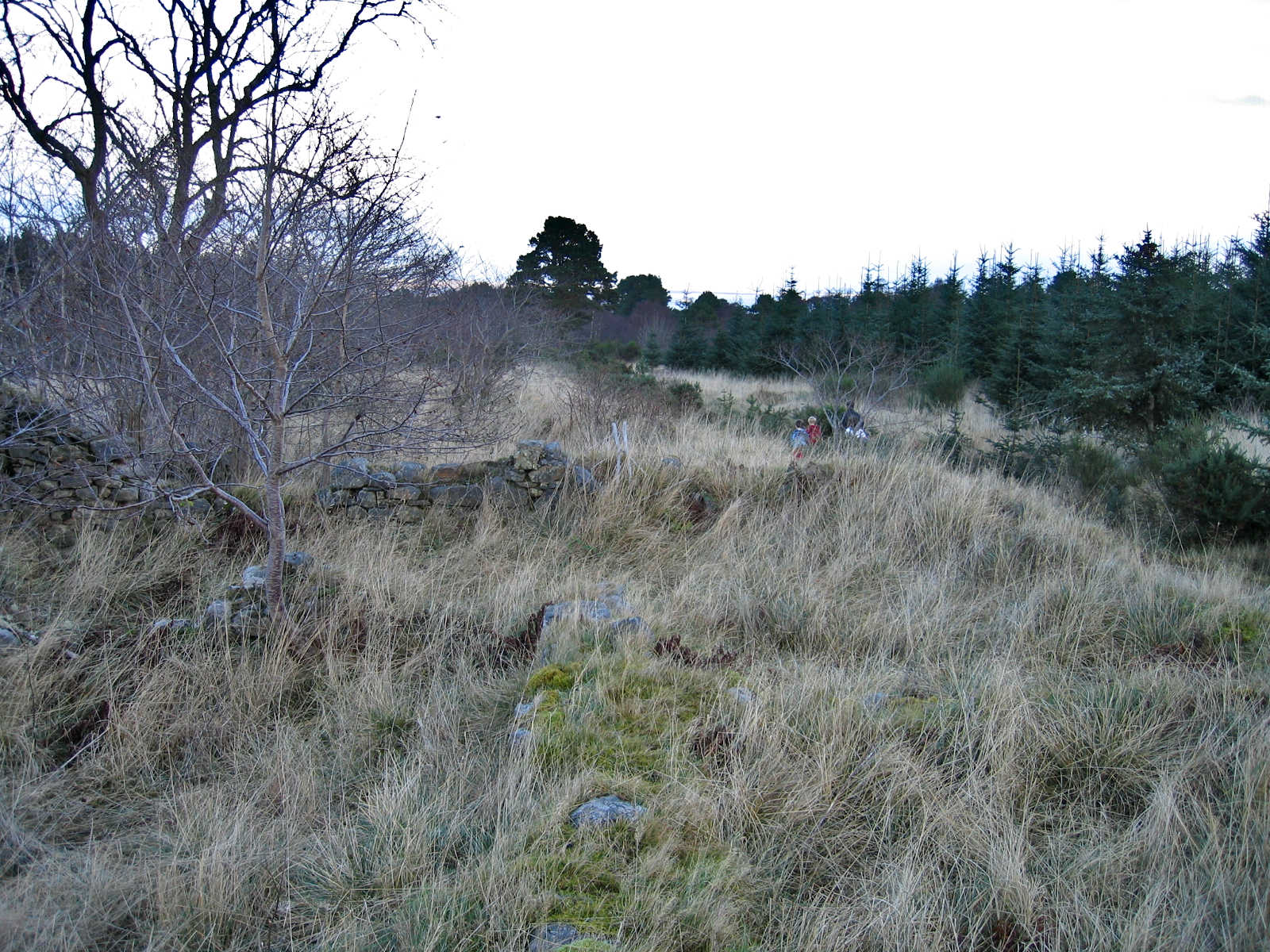
photo by Jim Mackay
And the name of Agneshill? Well, I have no proof that this was the origin of the name, but it seems likely. The only daughter born to David Urquhart of Braelangwell and Margaret Hunter, his second spouse, was Agnes. She was born in 1807 and sadly was to die in 1810, still an infant. But I suspect that with feminine examples such as Jemimaville, Barbaraville and Arabella in mind, David and Margaret wished the new settlement in the moors to be named after their daughter.
Appendix: Braelangwell and the Breaking of the Commonty
During the legal proceedings of 1816, when the testimony of many was sought in order to support the claims of the various estates, the assertive role of Braelangwell in establishing itself in the Mulbuie comes through loud and clear.
[7 September 1816] Compeared JOHN MOIR, in Kirktown of Avoch, aged 74, who being solemnly sworn, purged of malice, interrogated, depones, That, when he was about twelve or thirteen years of age, he entered the service of a Mrs Baillie, a residenter in this Burgh [Fortrose], and remained with her for seven years; the three subsequent years he was in service with Bailie Bremner, and his chief employment in both services was to go to Millbuy for turf and heather, and there were at that time about fifty horses used by the inhabitants of Fortrose in going to the Millbuy for the same purpose. … Depones, That he recollects, on one occasion, having gone as far as the property of Braelangwell or the burn of Auldaig, with these horses, for turf, and there were others besides him, and Braelangwell seized them all, and carried the horses to his court-yard; and that upon this being complained of to the magistrates of Fortrose, they sent their town-clerk to protest against the seizure and interruption, and the horses were sent back by Braelangwell; and, by the authority of the magistrates, the inhabitants of Fortrose and Rosemarkie went to that part of the moor where the interruption had taken place, and even beyond it, and continued for a week cutting turf and pulling heather, and they were never interrupted after that time; … Depones, It was when he was in the service of Bailie Bremner that Braelangwell seized the horses. … Depones, That the ground over which the servitude had been exercised began at the Strathburn, and extended north to the burn of Auldaig before mentioned; and to the west they were in the use of going as far as the summit of what is called St Patrick’s Hill: … Depones, That, about fifty years ago, he recollects his being employed by the masons of Fortrose to carry home stones that they had quarried in the Milbuy, within the boundary described. Interrogated for Mr Mackenzie of Flowerburn [owner of Braelangwell], depones, That the wood of Brae, belonging to Poyntzfield, now runs on this side of the burn of Auldaig; but at the time he was stopped by Braelangwell it had not been planted. All which is truth, &c.
Compeared WILLIAM SIMPSON, wright at Fortrose, aged about 68 … Depones, That he himself was not of the party that were interrupted by Braelangwell, as described by the former witness; but he has heard several people who are now dead, and were present at that interruption, describe it: That he understood from them, that it was at the burn of Auldaig the horses and carts were seized; and that they were carried to Braelangwell; and he understood the town-clerk went in consequence to Braelangwell, and by his interference the horses were sent back. And the inhabitants of Fortrose and Rosemarkie were ordered by the magistrates to go for a week together after that, to pull heather wherever they chose, betwixt Strathburn and the lands of Brae. Depones, That he considers the Milbuy to commence on the north side of the Strathburn, and to continue northward till it comes to the lands of Brae. [He corroborates more of John Moir’s testimony, as do many of the witnesses that follow.]
[12 September 1816, at Braelangwell] … Roderick Macfarquhar, Esq. as factor for Mr Mackenzie of Flowerburn, presented a claim for him as proprietor of the estate of Braelangwell, and desired to adduce evidence of the tenants thereof being in the habit of going to the Milbuy, which being agreed to,
Appeared CHARLES HOSACK, a cottar upon the estate of Braelangwell, aged 72 years, who being solemnly sworn, &c. depones, That he has been all his life, with the exception of seven years, a residenter on the estate of Braelangwell, and he knows that the proprietor and tenants of the estate have been in the constant and uninterrupted use of the commonty of the Milbuy, long beyond the period of 40 years. All which is truth, &c.
JOHN MACLEAN, tenant at Brae, aged 61, who being solemnly sworn, &c. depones, That he has been on the estate of Braelangwell all his life, and concurs with the preceding witness as to the proprietors and tenants of that estate having exercised the use of the commonty of Milbuy beyond the years of prescription. All which is truth, &c.
At Braelangwell aforesaid, the 13th day of September and year aforesaid, in presence of the commissioner and parties,
JOHN MACLEAN, a witness examined yesterday, who being again solemnly sworn, &c. depones, That he has resided on the estate of Brae all his life, as did his predecessors for some generations, and is well acquainted with the boundary of [Newhall] the claimant's estate to the south: That the march commences at the south-east, at the corner of Mr Munro of Poyntzfield’s Wood of Brae, where a march-stone was placed by the late Mr Urquhart:
That the boundary at the south-west is a dike dividing the claimant’s estate from the estate of Easter Culbo: That the deponent is not acquainted with the precise line running from the one point to the other, but that the Fleucheries is a good way to the north of the line he has described.
Depones, That he knows the young planting above Braelangwell and Brae, and considers all within that line and more the exclusive property of the claimant. And being asked by the claimant, Whether the deponent considers the hill of Knockandown and all within to the said planting, to be the exclusive property of the claimant? depones, That he does; but does not know how the line goes east and west from that point, whether straight or crooked, but that that hill is the southern boundary, and includes a sheugh or hollow called Slochmore.
Being interrogated by the commissioner, Whether he ever saw the people from other properties come within the line described? depones, That he has seen people from the south side of the hill come to the hollow of Slochmore, but never so far as the planting, but now that coal is plenty, they seldom come at all.
Depones, That he never saw any of Poyntzfield’s people come to the west of the march-stone above mentioned. And further depones, That the tenants of the claimant's estate used to go occasionally to the south of the boundary for turf, in the same way that people from the south side came to them, who were never stopped on either side.
Being interrogated by the claimant, What is the source and what the course of the burn Aulduig? depones, The source is at Fleucherie, and runs straight east till ye come to the crofts of Agnes Hill, then takes a turn north, and goes through the wood of Braelangwell.
Being interrogated by the common agent, When the crofts and houses at Agnes Hill were first placed? depones, That it was about thirty years and more, but not forty [so about 1785], and as he believes by the late Mr Urquhart. Being interrogated by the claimant, Whether or not the greatest part of the estate of Braelangwell, and the whole of the Wood of Brae, do not lie to the south and east of the burn of Aulduig? depones, That it does. Being interrogated by the common agent, What was the occupation of the ground at Agnes Hill before the crofts and houses were placed there? depones, That it was used for pasture by the tenants of Brae for their cattle, and he has seen Mr Barclay's cattle from Kirktown of Newhall there, when Mr Barclay was tacksman, but never saw the cattle from any other estate there. All which is truth, &c.
DAVID MACLEAN, tenant in Easter Brae, aged 54 years, who being sworn, &c. depones, That he has resided all his life on the estate of Brae, as did his forefathers for several generations, and concurs with the preceding witness as to the southern boundary, both at the east and west, and depones, That the line from the one to the other of these points runs some way to the south of the young planting, and rather more to the south at the west than at the east, and it goes by a small cairn which is now green. And depones, That all to the south he considers commonty. Depones, He does not consider the hill of Knockandown to be the property of Newhall, but that down from that point to the cairn he has described he considers common, but that the hollow called Slochmore is Newhall’s property.
Being interrogated, Whether he ever saw people from other properties come within the line of the cairn? depones, He has seen people pulling heather within that line, but that they never came the length of Agnes Hill. Depones, That he never saw any of Poyntzfield’s people come to the west of the march-stone. Depones, and concurs with the preceding witness as to the course and source of the burn of Aulduig; and also concurs with the preceding witness as to the period of placing the crofts and houses at Agnes Hill, and the exclusive possession thereof by the tenants of Brae and Kirktown; and also concurs as to the situation of the estate of Braelangwell and Wood of Brae, in reference to the course of the water of Aulduig.
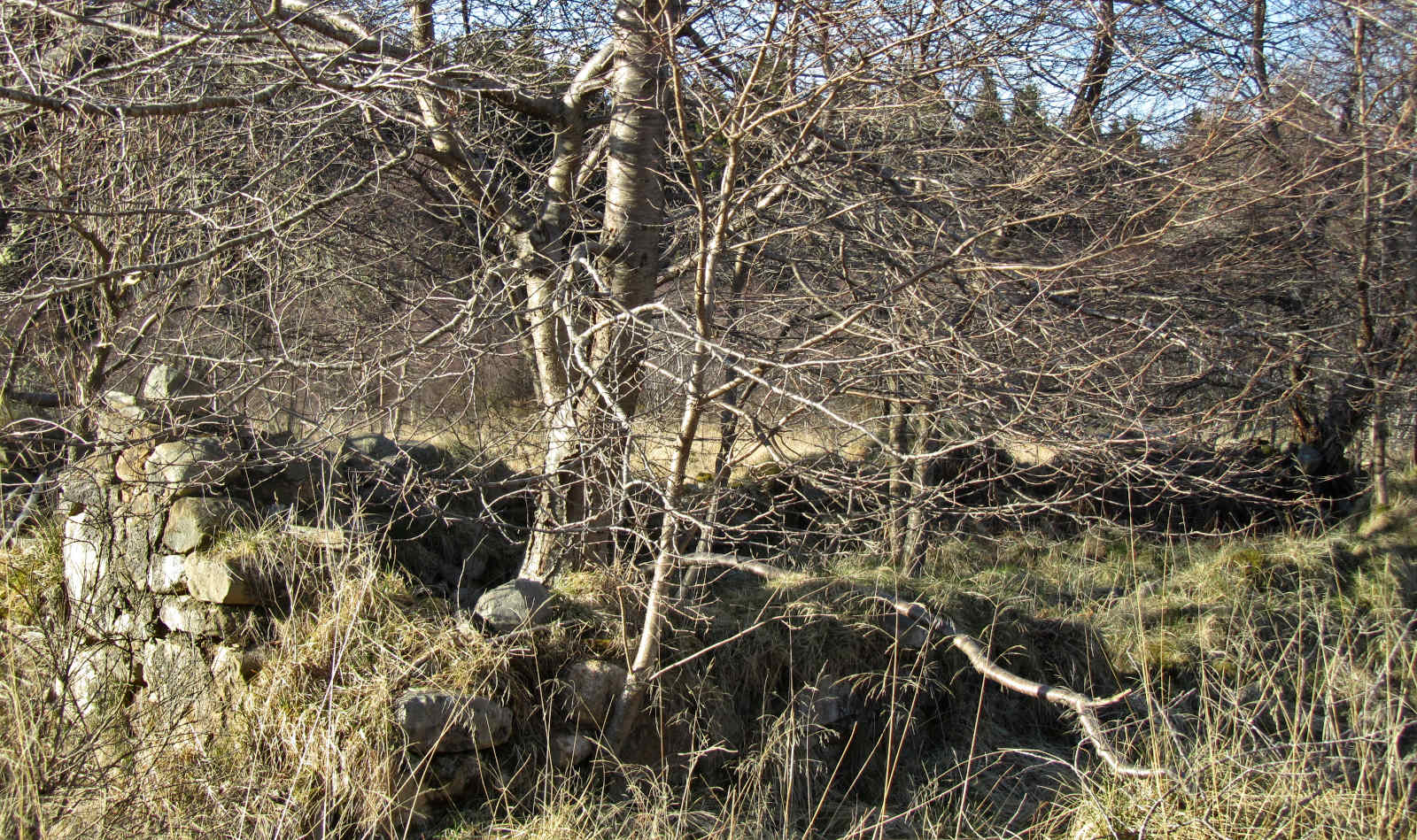
photo by Jim Mackay